« Halo Waypoint/Universe/Locations » : différence entre les versions
Aucun résumé des modifications |
Aucun résumé des modifications |
||
| Ligne 77 : | Ligne 77 : | ||
<big>'''Discovery'''</big><br> | <big>'''Discovery'''</big><br> | ||
On September 19, 2552, [[Halo Waypoint/Universe/Species#Humans|humanity]] stumbled upon Alpha Halo, and the [[Halo Waypoint/Universe/Vehicles#UNSC Pillar of Autumn|UNSC Pillar of Autumn]] crash landed on its surface while trying to escape the pursuing [[Halo Waypoint/Universe/Factions#Covenant|Covenant]]. When the Covenant unwittingly released the Flood onto the ring, the [[Halo Waypoint/Universe/Characters#Master Chief|Master Chief]] was forced to destroy it by detonating the UNSC ''Pillar of Autumn''’s fusion reactors. The ring’s destruction triggered the [[Halo Waypoint/Universe/Locations#Ark|Ark]] to forge a replacement. Months later, the Chief destroyed this ring as well, but this time by firing the partially constructed weapon in an effort to permanently quell the Flood. | On September 19, 2552, [[Halo Waypoint/Universe/Species#Humans|humanity]] stumbled upon Alpha Halo, and the [[Halo Waypoint/Universe/Vehicles#UNSC Pillar of Autumn|UNSC Pillar of Autumn]] crash landed on its surface while trying to escape the pursuing [[Halo Waypoint/Universe/Factions#Covenant|Covenant]]. When the Covenant unwittingly released the Flood onto the ring, the [[Halo Waypoint/Universe/Characters#Master Chief|Master Chief]] was forced to destroy it by detonating the UNSC ''Pillar of Autumn''’s fusion reactors. The ring’s destruction triggered the [[Halo Waypoint/Universe/Locations#Ark|Ark]] to forge a replacement. Months later, the Chief destroyed this ring as well, but this time by firing the partially constructed weapon in an effort to permanently quell the Flood. | ||
==Ark== | ==Ark== | ||
| Ligne 97 : | Ligne 96 : | ||
<big>'''Summary'''</big><br> | <big>'''Summary'''</big><br> | ||
Far beyond the periphery of the Milky Way galaxy resides an ancient and massive foundry known as the Ark. Approximately one hundred thousand years before [[Halo Waypoint/Universe/Species#Humans|humanity]] fought the [[Halo Waypoint/Universe/Factions#Covenant|Covenant]] above the Ark, the [[Halo Waypoint/Universe/Species#Forerunners|Forerunners]] used this massive machine to build a number of ringworlds—the [[Halo Waypoint/Universe/Tech#Halo Array|Halo Array]]. The Ark was also meant to be a refuge, giving selected species protection from the [[Halo Waypoint/Universe/Species#Flood|Flood]] and the Array itself in the event the rings were fired. At the end of the Human-Covenant War, the [[Halo Waypoint/Universe/Factions#UNSC|UNSC]] followed their enemies to this remote construct, prevented them from firing Halo. They also used a newly formed ring – intended to be a replacement for [[Halo Waypoint/Universe/Locations#Alpha Halo|Installation 04]] - to obliterate the extant Flood population. The Ark was heavily damaged in the process. | Far beyond the periphery of the Milky Way galaxy resides an ancient and massive foundry known as the Ark. Approximately one hundred thousand years before [[Halo Waypoint/Universe/Species#Humans|humanity]] fought the [[Halo Waypoint/Universe/Factions#Covenant|Covenant]] above the Ark, the [[Halo Waypoint/Universe/Species#Forerunners|Forerunners]] used this massive machine to build a number of ringworlds—the [[Halo Waypoint/Universe/Tech#Halo Array|Halo Array]]. The Ark was also meant to be a refuge, giving selected species protection from the [[Halo Waypoint/Universe/Species#Flood|Flood]] and the Array itself in the event the rings were fired. At the end of the Human-Covenant War, the [[Halo Waypoint/Universe/Factions#UNSC|UNSC]] followed their enemies to this remote construct, prevented them from firing Halo. They also used a newly formed ring – intended to be a replacement for [[Halo Waypoint/Universe/Locations#Alpha Halo|Installation 04]] - to obliterate the extant Flood population. The Ark was heavily damaged in the process. | ||
==Aleria== | ==Aleria== | ||
| Ligne 170 : | Ligne 168 : | ||
On April 26, 2526, multiple [[Halo Waypoint/Universe/Vehicles#Covenant Corvette|Covenant heavy corvettes]] attacked Circinius IV. As it was among the first planets attacked by the [[Halo Waypoint/Universe/Factions#Covenant|Covenant]], its population was unaware of the pending threat. Evacuations at Corbulo Academy itself were in progress when a Covenant corvette destroyed the campus’s space elevator. Only three students survived the assault, escaping the planet with [[Halo Waypoint/Universe/Characters#Master Chief|Master Chief Petty Officer John-117]]. | On April 26, 2526, multiple [[Halo Waypoint/Universe/Vehicles#Covenant Corvette|Covenant heavy corvettes]] attacked Circinius IV. As it was among the first planets attacked by the [[Halo Waypoint/Universe/Factions#Covenant|Covenant]], its population was unaware of the pending threat. Evacuations at Corbulo Academy itself were in progress when a Covenant corvette destroyed the campus’s space elevator. Only three students survived the assault, escaping the planet with [[Halo Waypoint/Universe/Characters#Master Chief|Master Chief Petty Officer John-117]]. | ||
<big>'''Notable Staff | <big>'''Notable Staff'''</big><br> | ||
'''Colonel Kennedy Lynn Mehaffey - Professor'''<br> | '''Colonel Kennedy Lynn Mehaffey - Professor'''<br> | ||
A hardened UNSC veteran of the Insurrection, Kennedy Lynn Mehaffey was raised on the outer colony of Desdoron. On her initial deployment as an [[Halo Waypoint/Universe/Factions#ODST|ODST]], a young Mehaffey was placed in a squad with a then-first-lieutenant Audrey Lasky. The two ascended the ranks together and both developed impressive reputations; Lasky for her encyclopedic intellect and Mehaffey for her relentlessness on the field. Her penchant for engaging rebels in close proximity, particularly in hand-to-hand combat with a blade—in addition to her often cold and calculated demeanor—earned her the handle "Icepick." | A hardened UNSC veteran of the Insurrection, Kennedy Lynn Mehaffey was raised on the outer colony of Desdoron. On her initial deployment as an [[Halo Waypoint/Universe/Factions#ODST|ODST]], a young Mehaffey was placed in a squad with a then-first-lieutenant Audrey Lasky. The two ascended the ranks together and both developed impressive reputations; Lasky for her encyclopedic intellect and Mehaffey for her relentlessness on the field. Her penchant for engaging rebels in close proximity, particularly in hand-to-hand combat with a blade—in addition to her often cold and calculated demeanor—earned her the handle "Icepick." | ||
| Ligne 184 : | Ligne 182 : | ||
In 2526, [[Halo Waypoint/Universe/Factions#ONI|ONI]]’s Section Two division informed Black about the burgeoning Covenant threat. He responded by increasing Marine troops around the campus. He also authorized limited communications blackouts under the guise of routine maintenance procedures. When the Covenant attacked Circinius IV, Black issued evacuation orders before joining the battle. He died during the initial Covenant ground assault. | In 2526, [[Halo Waypoint/Universe/Factions#ONI|ONI]]’s Section Two division informed Black about the burgeoning Covenant threat. He responded by increasing Marine troops around the campus. He also authorized limited communications blackouts under the guise of routine maintenance procedures. When the Covenant attacked Circinius IV, Black issued evacuation orders before joining the battle. He died during the initial Covenant ground assault. | ||
==Delta Halo== | ==Delta Halo== | ||
[[Fichier:H2A-Delta Halo (Way banner).jpg|center|800px]] | [[Fichier:H2A-Delta Halo (Way banner).jpg|center|800px]] | ||
{{quote|texte=}} | {{quote|texte=Delta Halo, or Installation 05, was part of the Halo Array, a series of ringworlds created for the purpose of destroying the Flood.}} | ||
[[Fichier:H2A-Delta Halo (Way square).jpg|left|250px]][[Fichier:H2A-Delta Halo (Way thumbnail).jpg|right|400px]] | [[Fichier:H2A-Delta Halo (Way square).jpg|left|250px]][[Fichier:H2A-Delta Halo (Way thumbnail).jpg|right|400px]] | ||
| Ligne 305 : | Ligne 302 : | ||
'''ZANZIBAR - War Games Map_Set/: 680-4'''<br> | '''ZANZIBAR - War Games Map_Set/: 680-4'''<br> | ||
In the late 2400’s the East African Protectorate launched an alternative energy campaign as part of its renationalization initiative. One prominent location was Zanzibar Island, which housed several wind and wave power stations. Wind Power Station 7 was decommissioned early in the 26th century and extensively utilized for classified military training exercises. Detailed records of Station 7 and scans of similar sites would later contribute to a number of notable War Games map sets. | In the late 2400’s the East African Protectorate launched an alternative energy campaign as part of its renationalization initiative. One prominent location was Zanzibar Island, which housed several wind and wave power stations. Wind Power Station 7 was decommissioned early in the 26th century and extensively utilized for classified military training exercises. Detailed records of Station 7 and scans of similar sites would later contribute to a number of notable War Games map sets. | ||
==Erebus VII== | ==Erebus VII== | ||
| Ligne 350 : | Ligne 346 : | ||
<big>'''End of Fathom'''</big><br> | <big>'''End of Fathom'''</big><br> | ||
Little of import was actually discovered during the Fathom’s exploratory commission, but in 2556, during a routine survey, the Covenant carrier suddenly shifted from its resting place, violently sliding down into a nearby trench and sending debris and water directly into the station’s northern terminals, tearing the complex apart and claiming the lives of 41 researchers. Splendid Intention would be lost forever, along with 23 explorers who were trapped within it; this solemn event triggered the end of Fathom Station’s research activity though it would secretly live on during War Games simulations. | Little of import was actually discovered during the Fathom’s exploratory commission, but in 2556, during a routine survey, the Covenant carrier suddenly shifted from its resting place, violently sliding down into a nearby trench and sending debris and water directly into the station’s northern terminals, tearing the complex apart and claiming the lives of 41 researchers. Splendid Intention would be lost forever, along with 23 explorers who were trapped within it; this solemn event triggered the end of Fathom Station’s research activity though it would secretly live on during War Games simulations. | ||
==Gamma Halo== | ==Gamma Halo== | ||
Dernière version du 5 novembre 2021 à 13:19
Genesis[modifier | modifier le wikicode]
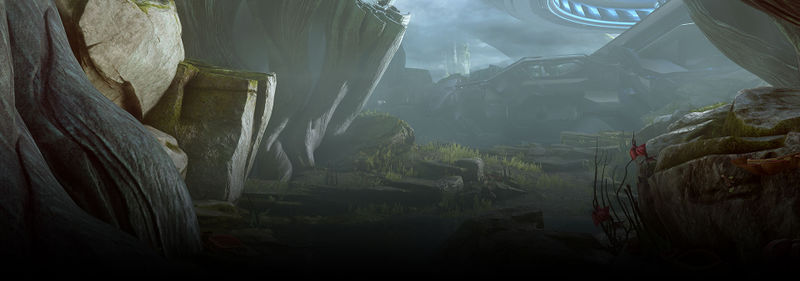
| « | Designed by Forerunner Builders over a hundred thousand years ago, Genesis houses a critical gateway to the enigmatic Domain. —
|
» |
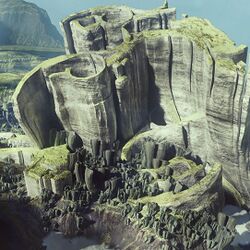
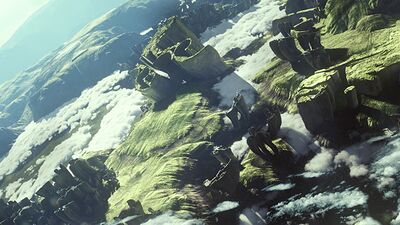
Genesis
Nomos II
Satellite: Nomos II-2, Nomos II-5
Diameter: 18,252 miles (29,374 km)
Gravity: .91 G
Atmosphere: 1 (N2, O2, Ar)
Star System: Nomos
Summary
The world of Genesis is an artificial planet utilized for the construction of ‘seed worlds.’ Mining natural satellites physically placed in orbit around the installation, Genesis used these resources to develop new worlds, populating them with the incredibly vast diversity of flora and fauna teaming on its own surface, so that they could be used for civilizations in need of them. In addition to this, Genesis housed a critical gateway facility connecting it to the Domain, an enigmatic information repository utilized by the Forerunners.
The Domain
The gateway was hidden on the planet, buried within the primeval coral highlands where its strong energy output could be masked by the site’s excessive bio-readings. Although this gateway was monitored and rarely utilized by the Forerunners, most of their civilization did not even know of its existence and used merely passive conduits to connect to the Domain. When Halo was activated at the height of the Forerunners’ war with the Flood, the gateway closed and the Domain was believed to be destroyed. 031 Exuberant Witness, the monitor charged with the installation’s manage, remained behind to care for Genesis.
Cortana’s Rise
In 2557, Cortana’s sacrifice to defeat the Didact forced her matrix into the Domain. There, she discovered that not only was the Domain slowly repairing itself, but her own rampancy (a smart AIs’ mandated mortality) was effectively cured while in the Domain, seemingly making her immortal. Believing that she was to reclaim the Mantle from the Forerunners, in 2558 she and the Warden Eternal began to awaken the Guardians, a destructive network of ancient machines, preparing to deploy them in order to enforce her newfound power. Spartans tracked her to Genesis, but were unable to stop her before she deployed the Guardians, placing much of the charted galaxy under her control.
Alpha Shard[modifier | modifier le wikicode]

| « | Alpha Shard is a fragment of the Halo ring Installation 04, which was jettisoned into space during the destruction of the ring at the hands of Master Chief John-117. —
|
» |
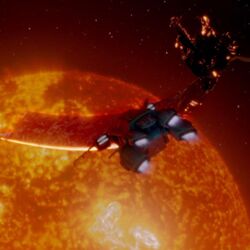
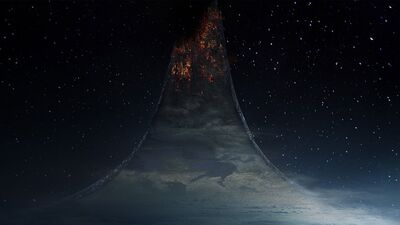
Alpha Shard
Fragment of Installation 04
Navigation Code: Location-6201
Anomaly Classification: Type-R3
Orbital Period: [REDACTED]
Day/Night Cycle: Accelerated
Maximum Surface Temperature: 900 degrees F
Summary
In 2552, the SPARTAN-II super soldier known as Master Chief John-117 successfully detonated the fusion reactors of the Halcyon-class cruiser UNSC Pillar of Autumn, destroying the alien artifact known as Installation 04 (Alpha Halo). Nearly all of the resulting debris was confirmed to have either fallen into the gravitational fields of the gas-giant Threshold or its moon, Basis. The remaining shards and pieces formed a debris field that remained in orbit. While various UNSC craft have surveyed and studied pieces of the broken ring - including the UNSC Red Horse in late 2552 – at least 30% of its mass and curvature remain unaccounted. The whereabouts of the missing material/objects are unknown, and no viable conjecture can be given at this time.
Discovery & Deployment
In late 2555, information was obtained from an Automated UNSC Scout Vehicle, Recon-14, which immediately piqued the interests of the Office of Naval Intelligence (ONI). The signal emanated from an area deemed Location 6201 and was quickly analyzed by multiple ONI specialists analyzed. However, it was a scientist and ONI attaché for astrophysical phenomenon, Dr. Madeline Tress, who correctly surmised that the signal had indeed come from the missing fragment of Installation 04.
Recon-14 itself had been deployed from the UNSC Pillar of Autumn before the cruiser’s initial crash-landing on the Halo ring. The drone’s survival, paired with other evidence, strongly infers that at least part of the ring either instigated or was enveloped in a significant slipspace event – far in excess of both human and (known) Covenant technology. The common theory holds that Recon-14 became stranded when the Halo itself attempted to activate an emergency slipspace jump once the Autumn’s reactors went critical; perhaps as one of the installation’s many self-preservation protocols. The action would not be successful as the Autumn detonated before Alpha Halo could fully enact the procedure. As a result, only a [REDACTED]-size fragment of the Halo would make its escape. The subsequent jump however would send the fragment tumbling through space upon reentering normal space, where it was caught in the gravitational field of a nearby star.
Current Status
Currently, the fragment appears to be at least partially functioning, even to the point of attempting to continually reduce radiation levels. However, the fragment’s spin exposes it to the harsh radiation emanating from its anchoring star during the fragment’s “day” period, which lasts approximately every 16 hours.
Though ONI and the UNSC have attempted to learn all they can about the Halo Array, much of its secrets remain unexplained. Central to these mysteries is the nature of the Halo’s regenerative abilities and sustainability protocols. Despite the extreme damage and trauma inflicted on the installation, it still inexplicably retains certain functionality with regards to the preservation of its intended environmental conditions. This is including but not limited to gravitational field integrity, atmospheric composition, and even biodiversity levels. Further research on the extant ring material and systems prior to the quarantine strongly infers that the rings are made of multiple redundant systems, including slipspace engines, terraforming facilities, artificial gravity, and weather control. The true nature of how these areas are tended to, as well as a complete understanding as to the original intentions behind such designs, remains a mystery.
Alpha Halo[modifier | modifier le wikicode]
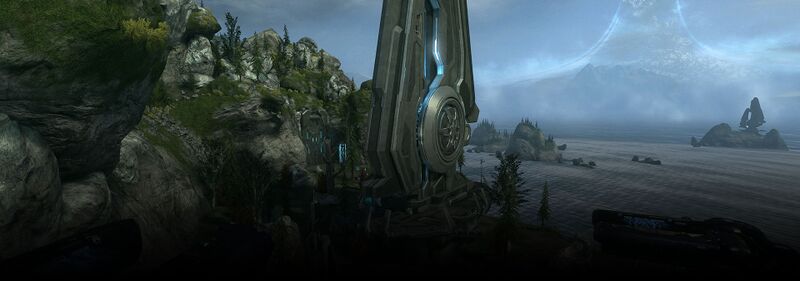
| « | Alpha Halo, or Installation 04, was part of the Halo Array, a series of ringworlds created for the purpose of stopping the Flood. —
|
» |
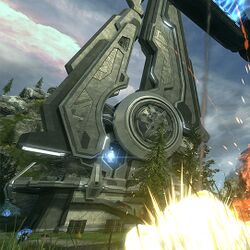
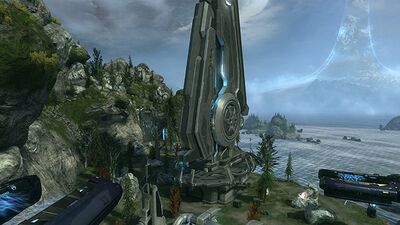
Alpha Halo
Installation 04
Affiliation: Forerunner
Star System: Soell
Gravity Anchor: Threshold/Basis
Monitor: 343 Guilty Spark
Diameter: 6,214 miles (10,000km)
Atmosphere: 1 (N2, O2)
Surface Temperature: -9°F to 104°F (-23°C to 40°C)
Summary
Over one hundred millennia ago, the Forerunners developed a collection of ringworlds, collectively called the Halo Array, in hopes of stopping the advancement of the merciless parasite known as the Flood. The firing of the Halo Array was the final effort by the Forerunners to save all life in the galaxy – ironically by destroying it, as the Array was meant to deprive the Flood of its food source: intelligent life.
Discovery
On September 19, 2552, humanity stumbled upon Alpha Halo, and the UNSC Pillar of Autumn crash landed on its surface while trying to escape the pursuing Covenant. When the Covenant unwittingly released the Flood onto the ring, the Master Chief was forced to destroy it by detonating the UNSC Pillar of Autumn’s fusion reactors. The ring’s destruction triggered the Ark to forge a replacement. Months later, the Chief destroyed this ring as well, but this time by firing the partially constructed weapon in an effort to permanently quell the Flood.
Ark[modifier | modifier le wikicode]
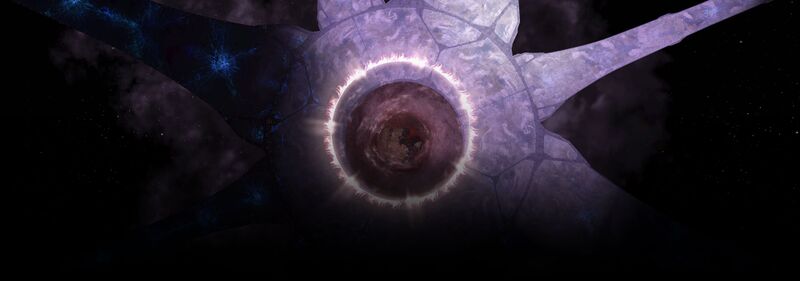
| « | The Ark was the massive installation used to create and deploy the Halo Array, a series of ringworlds created for the purpose of destroying the Flood. —
|
» |
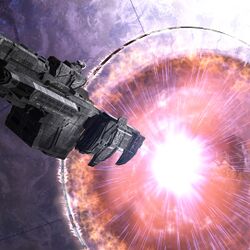
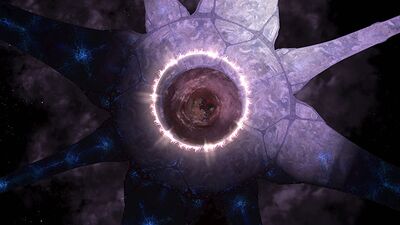
Ark
Installation 00
Affiliation: Forerunner
Diameter: 79,243 Miles (127,530km)
Gravity: 1.0 G
Atmosphere: 1.0 (N2, O2, Ar)
Surface Temperature: -22°F To 122°F (-30°C To 50°C)
Summary
Far beyond the periphery of the Milky Way galaxy resides an ancient and massive foundry known as the Ark. Approximately one hundred thousand years before humanity fought the Covenant above the Ark, the Forerunners used this massive machine to build a number of ringworlds—the Halo Array. The Ark was also meant to be a refuge, giving selected species protection from the Flood and the Array itself in the event the rings were fired. At the end of the Human-Covenant War, the UNSC followed their enemies to this remote construct, prevented them from firing Halo. They also used a newly formed ring – intended to be a replacement for Installation 04 - to obliterate the extant Flood population. The Ark was heavily damaged in the process.
Aleria[modifier | modifier le wikicode]
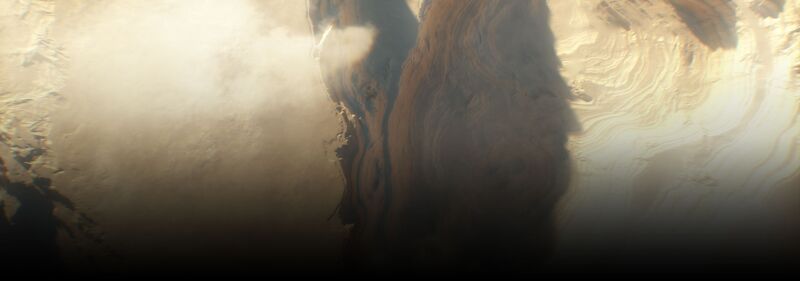
| « | The outer colony of Aleria is the second planet in the Elduros system. The majority of the population lives in extreme poverty due to a century-long drought. —
|
» |
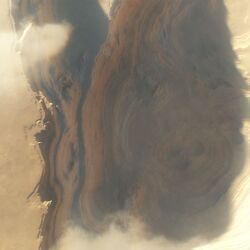
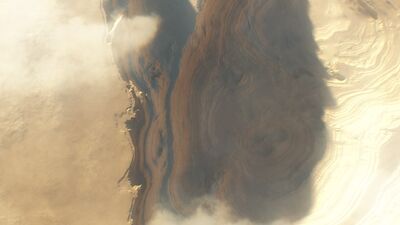
Aleria
Elduros II
Star System: Elduros
Summary
Once a thriving frontier colony famed for its rich mineral resources and robust economy, Aleria is now a dry, desolate, world home to some of the most desperate and dangerous pirate and smuggling groups in human space.
Collapse
The colonization of Aleria unfortunately occurred near the very end of a millenia-long period of low solar activity. Shortly after settlement, human terraforming efforts coupled with Elduros’ renewed instability threw the planet’s weather system into a dangerous feedback loop that caused massive droughts, which quickly turned the planet into an importer of most food supplies.
While the drought and terraforming setbacks caused concern for the nascent agricultural sectors, the resulting focus on mining Aleria for its rich ore deposits led to an overall expansion of new employment opportunities and economic activity. Alerian mining concerns, united under the Mols’Desia union, quickly established themselves as a powerhouse in the inner-outer colony trade, providing raw materials to fuel the expansion of human civilization in exchange for food, electronics, and spacecraft.
Nevertheless, the increasingly inhospitable climate and governmental mismanagement prompted a near-continuous state of emergency by the colonial administrators. Crackdowns and other efforts to enforce order only exacerbated tensions, with aggressive anti-centralization forces consolidating power in key outposts.
When the Covenant attacked in 2525, food imports effectively ceased and Aleria’s economy collapsed. By 2553, the population had fallen to half that of the previous century and the average lifespan was only 45 years of age. The planet remains outside of UEG control and assistance, having been written off years before by coldly rational cost-benefit analysis. Though mining continues, the planet’s impressive fleet of slipspace-cable transports has been co-opted by a multitude by various "courier guilds." While considered little more than petty smugglers and bandits by the UNSC, these courier guilds provide Alerians with a source of income and the ability to feed their families.
Alluvion[modifier | modifier le wikicode]
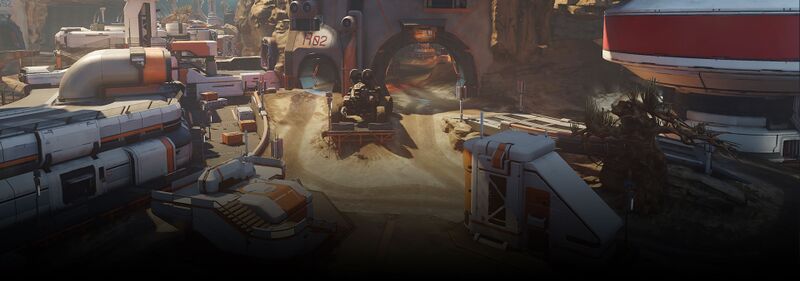
| « | Once a flourishing and vibrant colony world, Alluvion was home to millions of humans before the Covenant arrived in 2542. —
|
» |
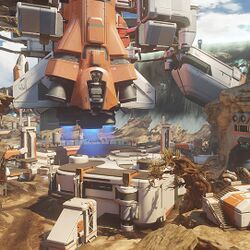
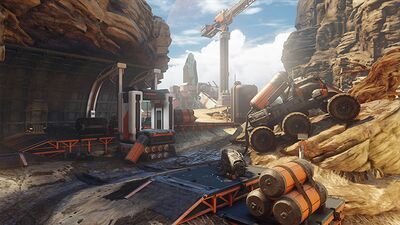
Alluvion
Bhaakto III
Star System: Bhaakto
Satellite: Fallow
Diameter: 4,307 miles (6,931 km)
Gravity: .99 G
Atmosphere: 1.1 (N2, O2)
Summary
Founded in 2412, the colony of Alluvion was a border world and prominent waystation between inner colonies and those located on the periphery. Its vast oceans and moderately tropical climates required little planetary engineering when humanity first arrived, though aggressive tidal activity due to the orbit of its moon, Fallow, forced most population centers into the continental interiors. Despite being highly cherished by those who lived there, Alluvion’s history remained largely uneventful until the Covenant’s arrival in 2542.
Battle for Alluvion
Covenant scouting patrols located Alluvion in 2541, signaling a full-scale invasion one year later. The UNSC managed to muster a substantial military force to defend the world, keeping the enemy at bay for weeks, before a Covenant support fleet arrived, severing critical support lines and bringing a quick end to the colony. The Covenant glassed major population centers and spaceports, leaving few survivors in its wake. By early 2544, no record of human activity remained on Alluvion.
Sundark Phenomena
Upon returning to Alluvion in 2554, the recolonization support fleet discovered a strange anomaly within the Sundark Sea. A series of Forerunner shield pylons, previously hidden from the colony’s inhabitants, had emerged and forced back massive walls of water revealing the seafloor. After years of surveying this area, an exploration team discovered a hidden repository containing an exotic fuel source thought capable of replacing deuterium for human starships.
Contracted by the UNSC, Liang-Dortmund’s aerospace division established the Alluvion Research Center (ARC) in 2556, seeking to directly power a number of prototype shuttles with this newfound energy source. Only a year into their research, however, their voracious mining efforts mysteriously triggered the complete withdrawal of the shield pylons, and the merciless collapse of the sea on all who remained within the ARC.
Corbulo Academy[modifier | modifier le wikicode]
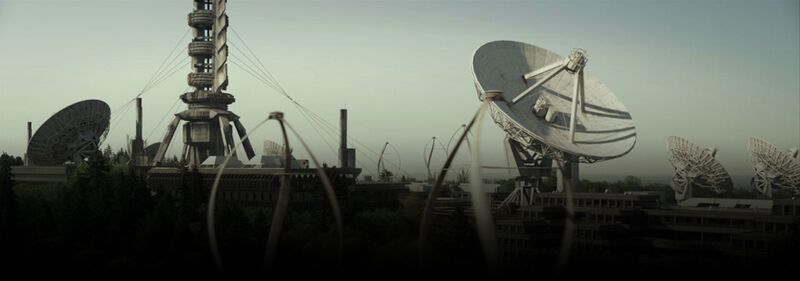
| « | Corbulo Academy of Military Science (CAMS) was a UNSC officer training school located on the colony world of Circinius IV. —
|
» |

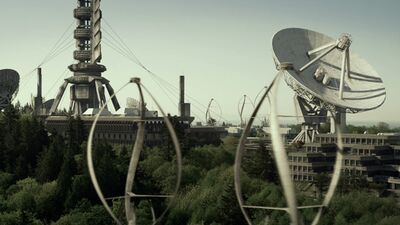
Corbulo Academy of Military Science
CAMS
Faction: UNSC
Location: Circinius IV
Superintendent: General Daniel Black
Destroyed: April 26, 2526
Summary
Corbulo Academy of Military Science (CAMS) was a UNSC officer training school. Located on the Unified Earth Government colony of Circinius IV, the school was tasked with preparing cadets for military service against the Insurrection. This school was named after the Roman General, Gnaeus Domitius Corbulo, who, when ordered to fall on his sword in the name of Rome, obeyed without question, shouting “Axios”—“I am worthy.” General Daniel Black, the superintendent at the time of Circinius IV’s fall, often said that the school was named after the Roman General because he represented the “honor, valor, and allegiance” expected of cadets. A statue of General Corbulo holding an MA5 series assault rifle stood in the central courtyard.
On April 26, 2526, multiple Covenant heavy corvettes attacked Circinius IV. As it was among the first planets attacked by the Covenant, its population was unaware of the pending threat. Evacuations at Corbulo Academy itself were in progress when a Covenant corvette destroyed the campus’s space elevator. Only three students survived the assault, escaping the planet with Master Chief Petty Officer John-117.
Notable Staff
Colonel Kennedy Lynn Mehaffey - Professor
A hardened UNSC veteran of the Insurrection, Kennedy Lynn Mehaffey was raised on the outer colony of Desdoron. On her initial deployment as an ODST, a young Mehaffey was placed in a squad with a then-first-lieutenant Audrey Lasky. The two ascended the ranks together and both developed impressive reputations; Lasky for her encyclopedic intellect and Mehaffey for her relentlessness on the field. Her penchant for engaging rebels in close proximity, particularly in hand-to-hand combat with a blade—in addition to her often cold and calculated demeanor—earned her the handle "Icepick."
Eventually, Mehaffey would be transitioned from active duty into the role of Director at the Corbulo Academy of Military Science on Circinius IV. Reportedly, she was famously transferred “without a scratch,” which soon prompted the academy’s students to speculate about the origins of her scar. With each graduating class, the theories and rumors would become more involved, eventually evolving into a popular urban legend that upperclassmen would pass down to new recruits. In reality, no one ever really learned the truth. Despite her reputation, she was as respected as she was feared, and in her service at the academy was instrumental in turning out some of the UNSC’s best and brightest for nearly ten years.
Her contributions would come to a tragic end in 2526, when she was killed in action during the Covenant’s surprise assault on the Academy at the time of their invasion of Circinius IV.
General Daniel Black - Superintendent
A proud Marine officer, Daniel Black earned his stripes during his involvement in Operation: TREBUCHET. Throughout the course of the war he was awarded numerous decorations and achieved the rank of General. Black maintained an unwavering loyalty toward the UNSC and viewed their military governance over the colonies as both necessary and practical. In juxtaposition to this, he ardently believed the insurrectionists selfishly endangered lives and that it necessitated swift reciprocity by the UNSC in order to prevent further losses.
After witnessing an increase of outer colony youth joining the rebellion, Black adopted the philosophy that the key to winning this war would be in a profoundly regimented pro-UEG education during the formative years. To that end, Black took on the role of superintendent of the Corbulo Academy of Military Science. He proudly made it his mission to prepare the cadets for their future in the UNSC and was known to personally intervene when a squad underperformed.
In 2526, ONI’s Section Two division informed Black about the burgeoning Covenant threat. He responded by increasing Marine troops around the campus. He also authorized limited communications blackouts under the guise of routine maintenance procedures. When the Covenant attacked Circinius IV, Black issued evacuation orders before joining the battle. He died during the initial Covenant ground assault.
Delta Halo[modifier | modifier le wikicode]
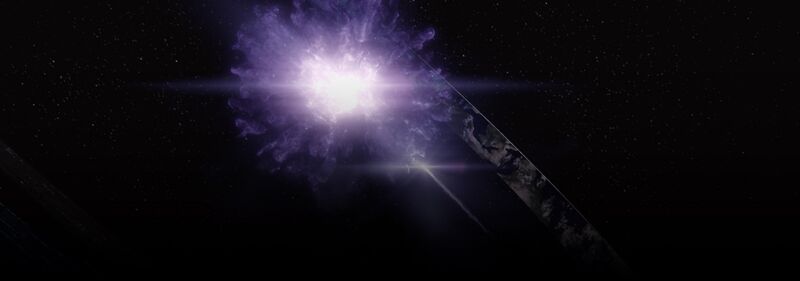
| « | Delta Halo, or Installation 05, was part of the Halo Array, a series of ringworlds created for the purpose of destroying the Flood. —
|
» |
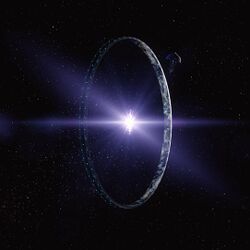
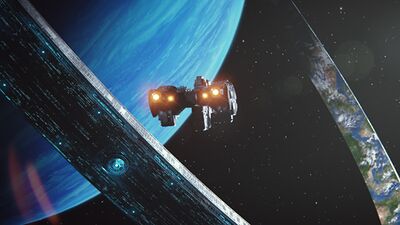
Delta Halo
Installation 05
Origin: Forerunner
Star System: Coelest
Gravity Anchor: Substance
Monitor: 2401 Penitent Tangent
Diameter: 6,214 miles (10,000km)
Gravity: 1.04 G
Atmosphere: 1.01 (N2, O2)
Surface Temperature: -2.2°F to 107.6°F (-19°C to 42°C)
Summary
Before activating the Halo Array, the Forerunners stored dormant specimens of the Flood on each installation for future study. However, centuries before humanity located Delta Halo, the installation’s containment protocols failed. This breach led to a Flood outbreak that festered for decades due to the disappearance of the installation’s monitor – 2401 Penitent Tangent.
On November 3, 2552, the Flood captured the UNSC In Amber Clad and use it to transport the Gravemind and hundreds of combat forms off the installation to High Charity during the chaos of the Great Schism. Though the Covenant capital was lost, Elite-controlled fleets quarantined the remaining Flood parasites on Delta Halo, cauterizing the Flood-controlled containment zone using orbital bombardment.
Lisbon Station
Though the surface of the ringworld is too dangerous for permanent habitation, the UNSC continues to monitor the installation and recover useful artifacts. These activities are staged from Lisbon Station, built a safe distance away from Delta Halo’s automated defenses.
Locations
ASCENSION - War Games Map_Set/: 118-3
When the High Prophet of Regret fled Earth, he was pursued by a number of UNSC vessels, including the corvette Coral Sea. To avoid discovery by the Covenant, the Coral Sea hid close to Delta Halo’s surface and devoted most of its time to scanning the ringworld. The crew discovered several communication relays across the installation’s surface and acquired information that is now used to reconstruct Delta Halo locations for research and War Games.
BACKWASH - War Games Map_Set/: 098-8
Delta Halo’s primary Flood containment facilities resided in remote regions of the ring, including a series of vast bogs and swamplands. It is believed the Forerunners did this to discourage potential intruders or at least obfuscate the truth of the facility below. At some point, the Flood breached the containment facility, leading to an outbreak and formation of a Gravemind. It is unknown whether a system malfunction or outside meddling led to the breach.
BEAVER CREEK - War Games Map_Set/: 250-5
To maintain its vast translocation grid, Delta Halo utilizes a dense web of telemetry conduits, with power generators buried in steep, narrow canyons. While scanning the installation’s surface, the Coral Sea acquired detailed information on one such canyon.
COAGULATION - War Games Map_Set/: 701-5
Discovered by the Coral Sea, current theories surrounding this canyon’s twin outposts suggests they were used by young Forerunner Warrior-Servants seeking to prove their prowess in combat arenas. Although naval strength or superior weaponry resolved most Forerunner conflicts, ancient warrior principles did advocate for close-quarters combat from time-to-time.
COLD STORAGE: War Games Map_Set/: 429-2
Scattered across the surface of Delta Halo were containment facilities designed to continually analyze Flood samples kept in various states of development. This particular facility specialized in determining the extremophilic thresholds of Flood-infected specimens before 2401 Penitent Tangent’s lax oversight led to a containment breach.
CONTAINMENT - War Games Map_Set/: 639-1
This frigid, canyon-enclosed, semi-symmetrical area is likely the result of semi-randomized Forerunner landscape creation. Though the quarantine wall was not part of standard Flood containment protocols, the installation’s outbreak and lack of monitor supervision required unique countermeasures.
DESOLATION - War Games Map_Set/: 320-5
The UNSC Coral Sea discovered this site - as well as many similar ones - hidden in Delta Halo’s dense jungles. Analysts believe this was once used by Forerunners to study the extensive collection of species retrieved by Lifeworkers during the Conservation Measure. After the activation of the Array and the dark time that followed, this facility was abandoned.
LOCKOUT - War Games Map_Set/: 036-8
Although the UNSC In Amber Clad was destroyed during Delta Halo’s Flood outbreak, the frigate’s data nodes had already transmitted extensive details of various sites on the ring’s surface to the Master Chief. One of these – a derelict structure fixed to the ledge of a distant mountain - was the source of considerable scientific debate after his return. Subsequent analysis indicates it may have been a Forerunner research site, but the findings remain inconclusive.
RELIC - War Games Map_Set/: 209-4
The surveillance team RECON 127 was deployed from the UNSC In Amber Clad shortly after the frigate arrived at Delta Halo. The detachment’s goal was a large structure buried under one of the installation’s many islands. Upon arrival, they encountered heavy Covenant resistance and their Albatross was shot down. Though the members of RECON 127 did not survive the following ground engagement, they did transmit a series of incredibly compelling scans of the site to In Amber Clad. The details revealed the site - dubbed ‘Relic’- was in actuality the remains of a long-dormant Forerunner vessel that had been carefully hidden below the island over one hundred millennia years ago.
REMNANT - War Games Map_Set/: 209-11
A secluded island, hidden along the coastal regions of Delta Halo, Remnant features a towering and iconic Forerunner megalith, weathered by untold millennia. Resembling other artifacts on Delta Halo, this enigmatic megalith became the site of comprehensive research by Lisbon pioneer groups.
SANCTUARY - War Games Map_Set/: 951-7
One data set acquired by the UNSC Coral Sea was the peculiar site dubbed ‘Sanctuary.’ In addition to advanced Forerunner architecture, Delta Halo also housed a number of stone ruins. Some have speculated these are not Forerunner structures, but were instead transported here for other species that were temporarily housed on the ring. The layout of the site indicates its purpose was more cultural than practical; possibly a memorial or cenotaph.
UPLIFT - War Games Map_Set/: 320-91
The UNSC Coral Sea eventually encountered a Covenant infantry detachment attempting to tap into one of Delta Halo’s critical power conduits. This energy node was designed to delicately control the direction and movement of the ring as it orbited the gas giant Substance, but the Covenant believed it was also of great religious significance.
WARLOCK - War Games Map_Set/: 405-2
Encountered by long-range survey remotes exploring Delta Halo, this looming and majestic set of structures is comprised of strange stonework that appears to have been transported from another location entirely. Its origins remain open to speculation.
Earth[modifier | modifier le wikicode]
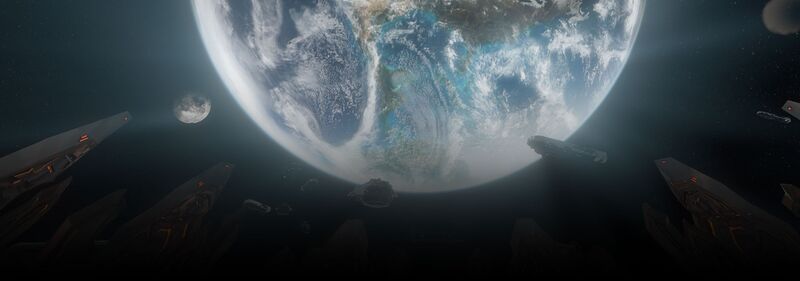
| « | Earth is the cradle world of the human species and the center of their political and military governance. —
|
» |


Earth
Sol III (Erde Tyrene)
Star System: Sol
Satellite(s): Luna
Diameter: 7,926 Miles (12,756km)
Gravity: 1.0 G
Atmosphere: 1.0 (N2, O2, Ar)
Surface Temperature: -4°F to 104°F (-20°C to 40°C)
Day Length: 24 Hours
Year Length: 365.2 Days
Summary
Earth, known as Erde-Tyrene in the ancient past, is the homeworld of the human species. It is the capital of the Unified Earth Government (UEG) and the center of UNSC power. With renewed civil unrest in the Sol system and the Covenant threat ever in question, Earth’s future hangs in the balance.
Habitation
Earth is the third world in the Sol star system. In stable orbit around Earth is one moon, Luna. By the end of the 21st century, humanity had establish colonies both in orbit and on Luna’s surface.
Locations
BLACKOUT - War Games Map_Set/: 037-2
Located in the Arctic Circle, UNSC Earth Weather Station Z/41 was originally a privately owned research platform. The stark location and imaginative rumors about alien life forms stored at the remote station made it a tempting site for reimagining in War Games.
FOUNDATION - War Games Map_Set/: 525-5
Deep within the Chicago Industrial Zone stands an abandoned testing facility, once home to Acheron Security’s early efforts at autonomous combat drones. With the rise of biologically augmented, cybernetically enhanced super-soldiers, the facility - and its original purpose - were deemed irrelevant. Nevertheless, the UNSC later leveraged the location for use in War Games combat simulations.
FOUNDRY - War Games Map_Set/: 040-44
To facilitate the storage of supplies and goods, Traxus Heavy Industries maintained a large network of warehouses all over Earth. The UNSC acquired detailed scans of one such abandoned warehouse - located near Traxus Factory Complex 71 - for live-fire training.
GHOST TOWN - War Games Map_Set/: 673-15
In the late 2400’s, the East African Protectorate initiated a number of renationalization initiatives, including the construction of many water purification facilities. The government’s Global Water Campaign built a large purification facility for the transport of snowmelt from Mount Kilimanjaro to the facility. The water was then filtered and pumped around Africa. In the early 26th century, the Mount Kilimanjaro Water Plant was decommissioned and acquired by the UNSC in order to conduct classified military training exercises for ingress/egress operations and War Game simulations.
ORBITAL - War Games Map_Set/: 420-6
The Quito Space Tether - constructed by the International Society of Civil Engineers - is one of the six space elevators on Earth and is located in San Francisco de Quito, South America. The building was completed on January 14th, 2313 but did not receive its current name until 88-years later at its rededication ceremony on March 9th, 2401. During the event, a monument to doctors Tobias Fleming Shaw and Wallace Fujikawa – co-creators of the Shaw-Fujikawa Translight Engine - was placed at the elevator’s orbital receiving station.
RAT’S NEST - War Games Map_Set/: 600-3
The 20th century Kenyan military base, Crow’s Nest, was located west of the industrial town of Voi, along the Tsavo Highway. This facility provided a military outpost for UNSC forces during the Covenant’s invasion of Earth until it was discovered by the Prophet of Truth’s forces. The UNSC later leveraged plans for the base’s ammunition storage facility - colloquially named Rat’s Nest - as an environment in War Games simulation.
STANDOFF - War Games Map_Set/: 550-7
One of the primary military sites responsible for deep space communications relay on Earth is Kupiga Simu, located within the East African Protectorate. This UNSC communications facility specializes in transmitting signals to and from locations across the Sol system. Given profound advances in the understanding of faster-than-light communication since the end of the Covenant War, this site has been rendered functionally obsolete, and is now primarily used as a Spartan training environment.
THE PIT - War Games Map_Set/: 590-1
While most contemporary combat simulations occur in the holographic and pneumatic world of War Games, UNSC Training Facility Bravo - alongside others located throughout the East African Protectorate - offer unfettered, live combat in real world settings. This methodology is the pride and joy of old-school drill instructors, whose lament the rise in illusory combat environs. Ironically, this site was then replicated in War Games as The Pit, a testament to its time-honored combat value.
ZANZIBAR - War Games Map_Set/: 680-4
In the late 2400’s the East African Protectorate launched an alternative energy campaign as part of its renationalization initiative. One prominent location was Zanzibar Island, which housed several wind and wave power stations. Wind Power Station 7 was decommissioned early in the 26th century and extensively utilized for classified military training exercises. Detailed records of Station 7 and scans of similar sites would later contribute to a number of notable War Games map sets.
Erebus VII[modifier | modifier le wikicode]

| « | Erebus VII is a prospective colony world covered in dense forestation and home to an abandoned UNSC research facility. —
|
» |
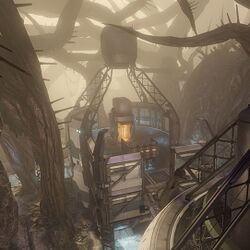
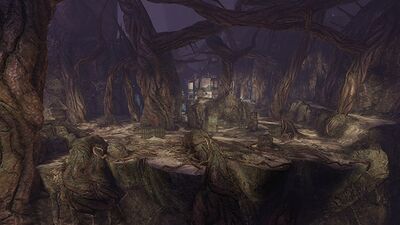
Erebus VII
Abandoned Colony<
Star System: Erebus
Gravity: 1.12 G
Atmosphere: 1.02 (O2, N2)
Summary
Though Erebus VII’s atmospheric composition makes it habitable, it has yet to be considered a viable candidate for colonial residence, due to extremely hostile indigenous wildlife and interference by the Office of Naval Intelligence (ONI). For some time, ONI had operated a number of facilities across Erebus’ immense equatorial forest, though their research goals have yet to be revealed. After ONI lost contact with onsite personnel in 2557, several remote contact teams were sent to determine the reason. They found empty labs, with no explanation as to the whereabouts of the staff. ONI has since suspended its efforts on Erebus VII and has no plans to commit new resources.
Designation
ABANDON - War Games Map_Set/: 505-2
Detailes an ONI research facility on Erebus VII have been used to create a map within the War Games combat simulation.
Fathom Station[modifier | modifier le wikicode]
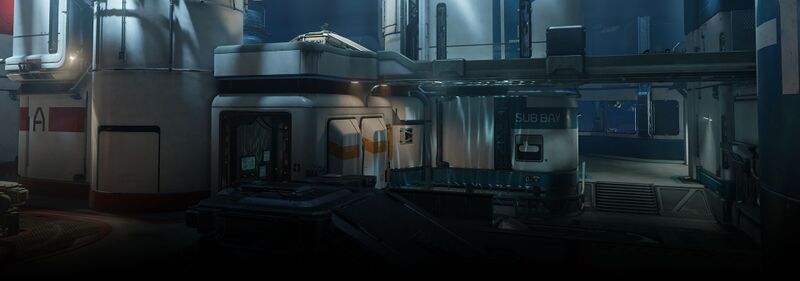
| « | Attempting to unlock mysteries of the war, Fathom Station was commissioned to research the Covenant’s Splendid Intention. —
|
» |
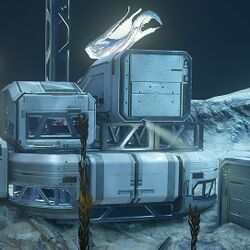
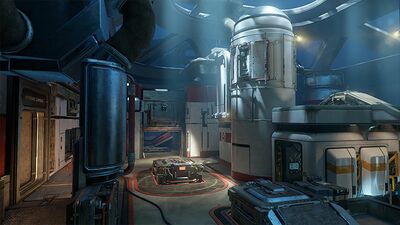
Fathom Station
UNSC Research Facility
World: Beta Gabriel
Function: Exploring Covenant wreckage off the Aleutian Rim
Summary
Fathom Station was an extensive network of underwater facilities nestled along the Aleutian Rim, in Beta Gabriel’s Cortez Ocean. It was designed to research and explore a submerged Covenant carrier rumored to house numerous technological secrets, including a weapon so powerful that it would render their already cruel orbital weapons obsolete. Funded by ONI and constructed by the Imbrium Machine Complex (IMC), Fathom operated unhindered for a number of years, though only gleaning mild discoveries.
History
When the Epsilon Eridani system fell in August 2552, most of its human population centers on Reach, Tribute, and Circumstance were obliterated. And although the smaller, ocean world of Beta Gabriel did see Covenant occupation, its lack of any major human settlements left it mostly intact upon their departure. During a brief skirmish, however, UNSC Uncommon Courage sacrificed itself to force the Covenant carrier Splendid Intention into the ocean, stopping it from transferring a prototype super-weapon to the frontlines of the war. Recognizing the significance of this potential find, ONI deployed a Xeno-Materials Exploitation Group in 2554, facilitated by the IMC, to recover whatever it was that the Covenant were building.
End of Fathom
Little of import was actually discovered during the Fathom’s exploratory commission, but in 2556, during a routine survey, the Covenant carrier suddenly shifted from its resting place, violently sliding down into a nearby trench and sending debris and water directly into the station’s northern terminals, tearing the complex apart and claiming the lives of 41 researchers. Splendid Intention would be lost forever, along with 23 explorers who were trapped within it; this solemn event triggered the end of Fathom Station’s research activity though it would secretly live on during War Games simulations.
Gamma Halo[modifier | modifier le wikicode]
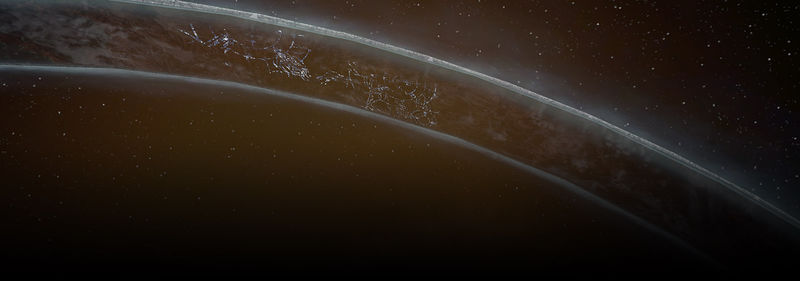
| « | —
|
» |
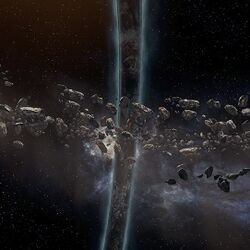
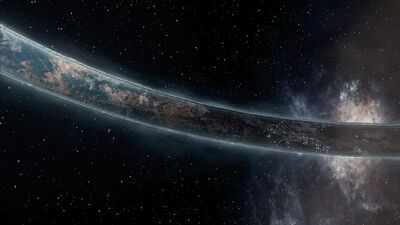
Gamma Halo
Installation 03
Origin: Forerunner
Star System: Khaphrae
Monitor: 049 Abject Testament
Diameter: 6,214 Miles (10,000km)
Gravity: 1.1 G
Atmosphere: 1.2 (N2, O2, Ar)
Surface Temperature: -6°F To 109°F (-21°C To 43°C)
Summary
Also known as Installation 03, Gamma Halo was discovered on October 8, 2552, when a human civilian transport, the Floral Express, appeared in the Khaphrae system after executing a random slipspace jump while escaping the Covenant assault on Tribute.
Within weeks, ONI pioneer groups, accompanied by Spartan escorts, secured the Halo’s Activation Index and quarantined areas which were believed to contain Flood research samples. Though the facility’s monitor, 049 Abject Testament, was not found, records found in the Gamma Halo Library complex led researchers to conduct targeted seismic scans near a Forerunner-sealed site in a desolate region of the ring, revealing a curious Forerunner artifact known as the Composer.
High Charity[modifier | modifier le wikicode]
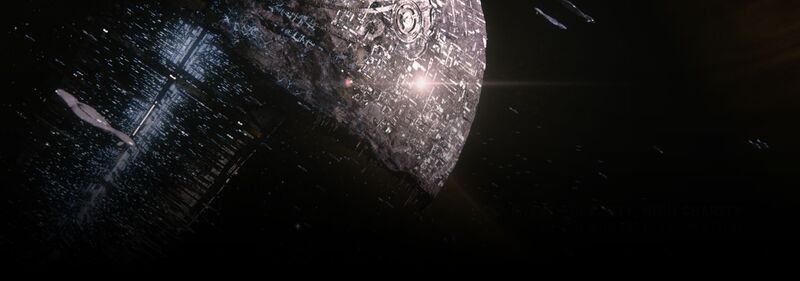
| « | HIGH CHARITY The Holy City of High Charity was an enormous mobile space station used as the capital of the Covenant empire. —
|
» |
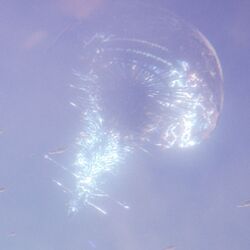
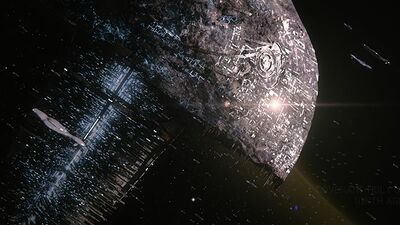
High Charity
The Holy City of High Charity
Diameter:
Atmosphere:
Standard Climate: 50°F To 75°F (10°C To 24°C)
Day Length: 265.2 Hours
Summary
The Holy City of High Charity was an enormous mobile space station created early in Covenant history to exist as a centralized capital of their religious, political, and military force, as well as the home to millions of Covenant constituents. As a testament to their truce with the Sangheili, the San’Shyuum used their Forerunner Dreadnought, set within the station’s interior, as High Charity’s primary power source. Around the ship’s moorings, the Covenant developed a vast metropolitan complex which covered the city’s primary floor, extending from the center all the way to its interior walls. Externally, High Charity was heavily armored and maintained a substantial umbilical docking system and maintenance facilities on its lower sections.
Despite its size and power, High Charity was destroyed toward the end of the war with the humans. When the High Prophet of Truth brought High Charity to Delta Halo in 2552, the Flood found its way onboard and rapidly infected the city’s population. Amid this chaos, Truth escaped with the Forerunner Dreadnought, leaving the High Charity’s citizens to fend for themselves. Eventually, High Charity met its end when the Gravemind crashed it into the Ark in an attempt to prevent the Halo Array from firing.
Locations
Gemini- War Games Map_Set/: 840-5
Although under control of the Flood parasite, the UNSC In Amber Clad continued to transmit data to its remote nodes, attempting to accumulate as much information about both Delta Halo and High Charity as possible before the ship’s termination. Remote relays captured these details and one peculiar mass image was a site within High Charity now believed to be the Garden of Reverent Contemplation. This site was believed to be a place of thought and worship dedicated to the High Prophet of Truth. The intention of this place was quiet solitude in honor of the Hierarch, but Spartans currently use Gemini’s impressive symmetry and multiple levels to more acutely hone their combat skills.
Harvest[modifier | modifier le wikicode]
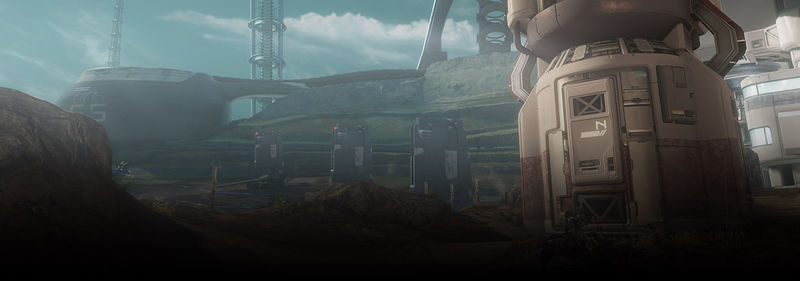
| « | Peaceful, serene, and sparsely populated, the farming colony of Harvest had no real defense to mount against the merciless Covenant invasion that began in 2525. —
|
» |
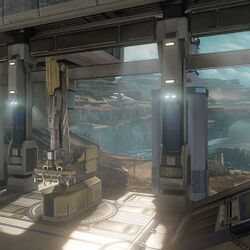
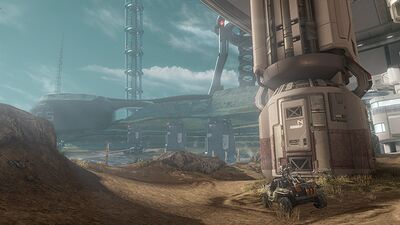
Harvest
Epsilon Indi IV
Star System: Epsilon Indi
Satellite: None
Diameter: 2,493 miles (4,012 km)
Gravity: 0.998 G
Atmosphere: 1.02 (N2, O2)
Surface Temperature: -2°F to 108°F (-19°C to 42°C)
Day Length: 17.5 hours
Founded: 2468
Summary
Found in the Epsilon Indi system, Harvest was a chief exporter of agricultural goods throughout human-occupied space for almost a century, until it became the first of many colonies to be destroyed by the Covenant in 2525. Prior to its fall, Harvest’s impressive seven tethers were connected to the orbital space station Tiara and managed by the AI construct Sif.
Ancient Past
Before the activation of Halo, the Forerunners knew Harvest as CE-309-8 d. A minor asset in their vast interstellar domain, the planet was used as a Shield waystation facility, complete with Flood research/containment centers and administrative nodes that directed Forerunner defenses in the surrounding region. Covenant excavations later revealed several of these Forerunner structures.
Fall of Harvest
In 2525, the colony was assaulted by the Covenant and communications were cut off to the UEG and UNSC. For several months, the fate of the colony remained a mystery, but in 2526, Vice Admiral Preston Cole arrived with one of the largest fleets ever assembled. Despite incredible losses, he drove off the Covenant fleet, but his forces became entangled in a vicious siege that lasted over five years.
Locations
Harvest - War Games Map_Set/: 309-8
The tether complex was a series of seven strands mounted just outside of the city of Utgard and terminating many kilometers above the planet’s surface at Tiara Station. Extensive scans of the complex prior to the Human-Covenant War have been uploaded into the War Games simulations for use in training Spartans.
Janjur Qom[modifier | modifier le wikicode]
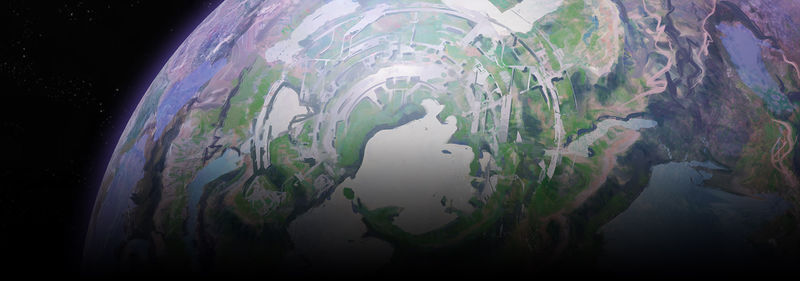
| « | Janjur Qom was the cradle world of the San’Shyuum. After a dispute, a renegade faction stole the Forerunner Dreadnought, leaving the planet forever. —
|
» |

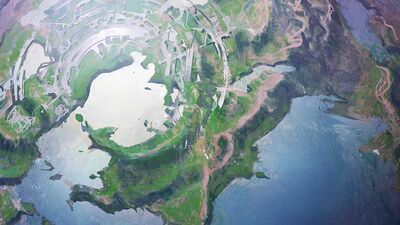
Janjur Qom
San’Shyuum Homeworld
Star System: [UNKNOWN]
Satellite: Plaon
Diameter: [UNKNOWN]
Gravity: [UNKNOWN]
Atmosphere: Comparable to Earth or Sanghelios
Surface Temperature: [UNKNOWN]
Day Length: 30 hours
Year Length: 290 days
Summary
Janjur Qom was one of three planets in the nascent star system of the San’Shyuum. Following a civil war, a group of renegade San’Shyuum fled the planet, taking with them the Forerunner Dreadnought. As the massive ship had been partially buried below the Great Apothtea - a vast blue sea - a sizable chunk of Janjur Qom was ripped from the planet in the escape. The ocean rushed to fill in the resulting crater.
After the formation of the Covenant, details about Janjur Qom were kept secret by the San'Shyuum leadership - even among their own species. Most knew few, if any, details that could help locate or identify it.
Habitation
Records indicate that much of the main continent was covered by dark green vegetation and dense forests with high canopies, while the outer regions were more rugged and rocky. These barren regions held many mysterious artifacts and facilities, including ruins dating back to when the San’Shyuum supposedly once walked among the Forerunners, though many who dwelt on Janjur Qom forbade their excavation and study.
Destruction
In 648 BCE, the San’Shyuum homeworld is said to have been destroyed when its star went supernova. This was viewed with some suspicion by many in the Covenant, but little was done to dispute it, and only the most revered Prophets knew where the world was located. At this point, High Charity became the adopted homeworld of all surviving San’Shyuum.
Kamchatka[modifier | modifier le wikicode]
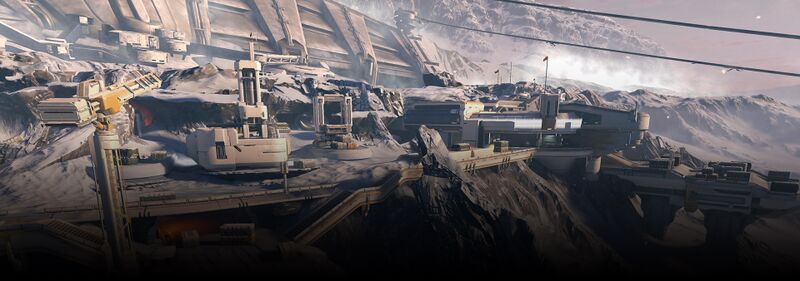
| « | Kamchatka is a remote, uninhabited world that once served as an important link in the Forerunner knowledge network known as the Domain. —
|
» |
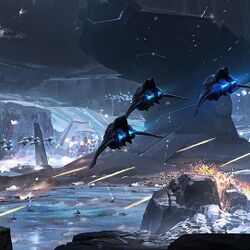
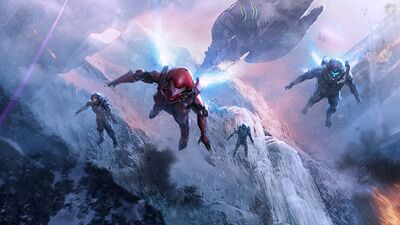
Kamchatka
Caspar V
Star System: Caspar
Satellite(s): None
Diameter: 3,231 Miles (5,200km)
Gravity: 0.98 G (anomalous)
Atmosphere: 0.7 (CO2, O2, N2
Surface Temperature: -125°F To 10°F (−87°C to -12°C)
Summary
Kamchatka would have remained an obscure world at the fringes of civilization but for the presence of a Forerunner communication hub that flared to life in 2558, attracting the attention of both Jul ‘Mdama’s Covenant and the UNSC.
Domain Node
It is unclear what role that Kamchatka played in the Forerunners’ galaxy-spanning ecumene or reasons for its recent activity, beyond it serving as a link in the long-dormant Domain – the Forerunner knowledge network that once linked their empire together.
The planet itself is obviously a product of some level of megascale engineering, though there is a curious lack of obvious Forerunner facilities on its surface. Other, larger, structures are buried under the snow and ice but no detailed surveys have yet been conducted to assess their condition. The first Forerunner site of its kind to be discovered, none know what to expect when they work their way to its heart.
Locations
March on Stormbreak - War Games Map_Set/: 309-8
The Stormbreak mountain range is the broken spine of Kamchatka, mended a thousand millennia ago by the Forerunners' godlike power. Shortly after Kamchatka's discovery, the UNSC set in motion a plan to establish a military complex and power station to control the planet's Forerunner sites.
Mars[modifier | modifier le wikicode]
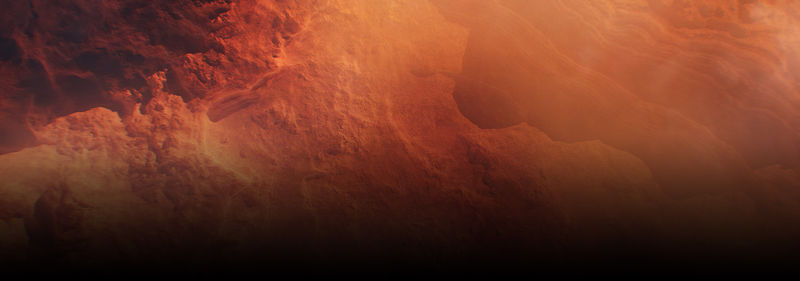
| « | In the many years since Mars became the first human-colonized planet, it has become a hub for industry and home to critical UNSC facilities. —
|
» |
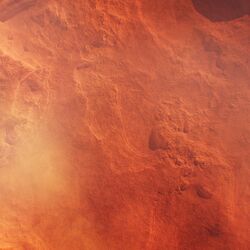
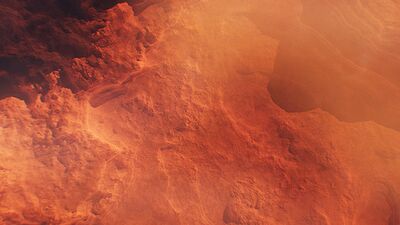
Mars
Sol IV
Star System: Sol
Satellite(s): Phobos, Deimos
Diameter: 4,220 Miles (6,792km)
Gravity: .376 G
Atmosphere: 0.7 (CO2, N2, O2)
Surface Temperature: -120°F To 80°F (−84°C To 26°C)
Day Length: 24 Hours, 39 minutes, 35 seconds
Year Length: 668.6 Days
Summary
In 2080, Mars became the first planet colonized by humanity. Even before terraforming, Mars quickly became a major industrial hub in the Sol system. The city of Kenosha in the Tanais region has the distinction of being home to the UNSC Marine Corps’ ODST headquarters.
Rebellion
Mars has the dubious distinction of being the first colony to rebel from Earth’s control. In the events leading up to the Interplanetary War in 2164, Mars harbored many activists and rebels who would later take part in the conflict. When the first shots were fired, many Martians joined the neo-Communist Koslovics. These revolutionaries were eventually put down in harsh crackdowns that followed the signing of the Callisto Treaty in 2170.
Covenant War
After centuries of tranquility, Mars once again saw war when the Prophet of Truth’s fleet arrived in the Sol System in late 2552. Though the UNSC forces on the planet were eventually destroyed, their valiant defense delayed Covenant forces from pressing their assault on Earth.
Notable Locations
New Manila, New Legaspi, Chiron Testing Station, Chiron TL-34, Argyre Planitia, Mare Erythraeum, Phobos Penal Colony, ODST Primary HQ (Kenosha)
Meridian[modifier | modifier le wikicode]
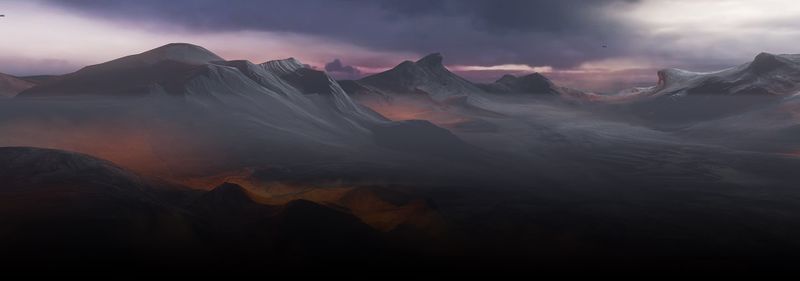
| « | Once a vibrant and thriving human colony on the periphery, Meridian was brought to ruin by a ruthless Covenant attack near the end of the war. —
|
» |
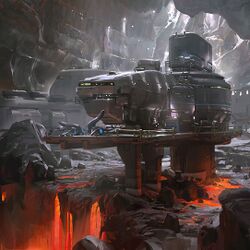
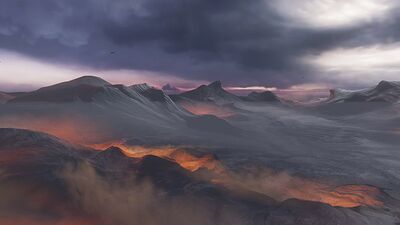
Meridian
Hestia V, g
Star System: Hestia
Gravity Anchor: Hestia V
Diameter: 1,905 miles (3,073 km)
Gravity: 1.1 G
Atmosphere: 1.2 (N2, O2)
Surface Temperature: -34.6°F to 109.4°F (-37°C to 43°C)
Summary
Meridian is the natural satellite of the gas giant Hestia V. Its impressive, Earth-like features, earmarked it early for human colonization. Although an Outer Colony, Meridian’s natural makeup and rich culture, attracted many outsiders, eventually fueling a robust economy and cultural diversity. Before the war, Meridian was easily one of the most vibrant and quickly growing colonies in all of human space. Now, however, years after the Covenant’s vicious assault, only a small pocket of Liang-Dortmund contractors can be found on its surface. Huddled around their only remaining space elevator, these excavators have constructed makeshift town referred to as Meridian Station.
History
Founded in 2431, Meridian’s colonists initially took residence along the verdant equatorial coastlands, later migrating to the vast supercontinent, which would be the center of Meridian civilization for decades. Despite a number of conflicts fueled by antagonistic political ideologies, including the Free Patriot Movement of 2457 and the Sundered Legion of 2495, intervening decades ultimately led to the colony’s stabilization. Military contractors such as the Chalybs Defense Solutions took residence there in 2479, and the even though the Insurrection had some level of prominence on Meridian, prior to the Covenant War there was a strong UNSC presence across the moon.
Covenant Attack
When humanity was already decades into the Covenant War, most of those on Meridian thought they had somehow evaded the alien alliance. Such was not the case. In 2548, the Covenant found Meridian and began their attack, attempting to cut off supply lines from the colony to other fronts in the war. Meridian’s impressive Air Force and their extensive orbital defensive grid allowed them to fight for three full years, before the Covenant’s sheer power swept away the colony’s resistance. By 2551, the world had been reduced to molten slag and vitrified soil.
Locations
The Rig - War Games Map_Set/: 769-2
Still clinging to the ghosts of commerce, mining platforms like this one scour what remains of the world’s surface—a tragically hollow attempt to resurrect Meridian’s past opulence and splendor.
Darkstar Station
While the loss of Pinnacle Station dealt a massive blow to Liang-Dortmund’s operations on Meridian, demand for the planet’s vitrified resources has neither slaked nor slowed. Working quickly and quietly to avoid the notice of the Created, regional directors at Liang-Dortmund quickly implemented contingency plans to mitigate the economic impact and reconstitute operations on the frontier planet-moon. Though the company’s local headquarters at Meridian Station was devastated, the remote polar outpost of Darkstar Station survived, its workers and engineers largely unaware of the disaster that unfolded on the other side of the planet and the uncertain future that awaits them under Cortana’s rule. Despite the uncertain astro-political climate, Liang-Dortmund continues an accelerated resource gathering operation while tacit permission exists, transferring one of its largest resource processor ships, additional workers, and human resource specialists to Meridian’s orbit in order to continue work and assess the company’s remaining investments. But anomalies abound beneath the battered surface as ancient machinery buried deep in the planet’s mantle stir to life, and the UNSC makes plans to once again revisit the surface in search of answers, regardless of what forces that intervention may unleash.
Jorta Station
Jorta Station was an important cog in Liang-Dortmund's operations on Meridian, as the site was a central hub for the megacorporation's seismographic network and labs devoted to solving the hard problems of "deglassing" the planet. Due to the sensitive nature of the task at hand, Jorta Station also served as the command center for Liang-Dortmund’s private security forces, housing a fleet of Warthog utility vehicles, Pelican dropships, Scorpion tanks, and Mantis walkers in case of intrusion by Kig-Yar raiders or rival corporations seeking to conduct kinetic espionage.
Munera Platform[modifier | modifier le wikicode]
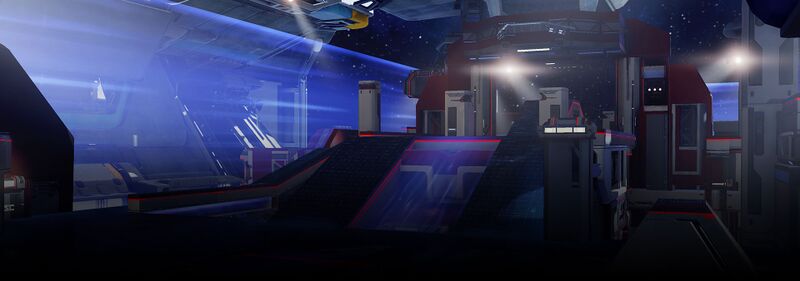
| « | One of many just like it, Munera Platform A7 plays host to an array of War Games simulations conducted by battle-hardened Spartans. —
|
» |
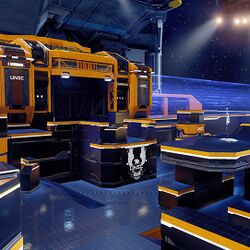
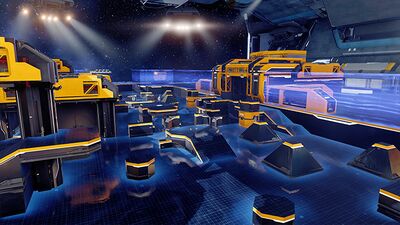
Munera Platform
War Games Combat Orbital
Anchor: Earth
Function: Corporate-sponsored combat simulation for materiel improvement
Summary
Created shortly after the activation of the SPARTAN-IV program, orbital combat stations such as Munera Platform A7 are designed as a discrete, self-contained arenas, capable of simulating a vast number of terrains and scenarios. Utilizing War Games technology, the platform can readily generate any environmental schema using advanced holographic and hard light technology. Although it can cater to a number of practical scenarios, it’s most common involves two surgical fireteams facing-off in a symmetrical, or semi-symmetrical arena.
Sponsored by weapon and armor manufacturers, corporations are able to analyze the raw data on these simulations, allowing them to better enhance their own product lines, while the UNSC leverages these events to train and hone Spartans during periods of relative peace. Combat orbitals have subsequently been utilized by all of the UNSC’s Armed Forces, garnering a large internal following, becoming something of a spectacle within ranks, fostering cross-branch competition. Munera Platforms exist across human-occupied space, though Earth and Mars presently have the largest numbers.
New Mombasa[modifier | modifier le wikicode]
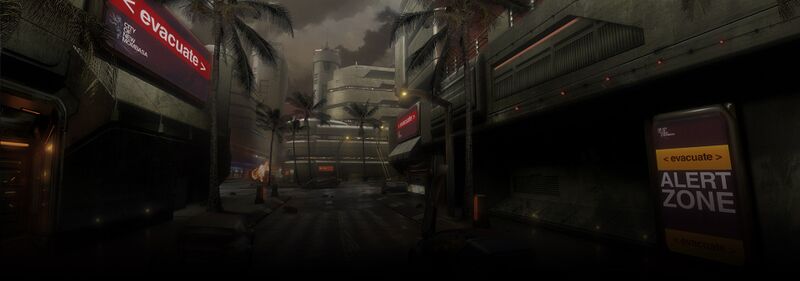
| « | Home of Earth’s first space elevator, New Mombasa developed into a sprawling metropolis. The city was mostly destroyed by the Covenant during their assault of Earth. —
|
» |
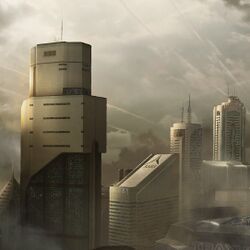

New Mombasa
Kenya, Africa, Earth
Government: East African Protectorate
Key Features: Mombasa Space Tether
Key Technology: Superintendent
Destroyed: October 20, 2552
Summary
On October 20, 2552, the High Prophet of Regret arrived in the Sol system with a small Covenant fleet. Regret’s flagship, Solemn Penance, quickly broke through Earth’s orbital defenses and initiated a ground assault on New Mombasa to seize control of a Forerunner artifact buried beneath the city. UNSC forces from Diego Garcia and the Master Chief were immediately deployed ground-side in an effort to stop the Prophet. In addition, as the Solemn Penance hovered above the city, an ODST task force prepared to drop onto the vessel and seize it in a boarding action.
Before either party could complete their mission, Regret leveraged the newly discovered location of Delta Halo as an escape vector, and Solemn Penance made a sudden slipspace jump near the city. The slipspace rupture created a massive crater to the northeast of the city, sheared apart the orbital elevator, and unleashing a shockwave that caused extensive damage to the city. Soon after, the Covenant fleet arrived in force and began to glass the city in order to uncover the nearby Forerunner portal structure.
Locations
District - War Games Map_Set/: 411-1
During the Covenant’s first assault on Earth and the occupation which would follow, Old Mombasa became a key engagement point for UNSC forces seeking to prevent the Covenant from establishing what they initially believed to be an invasion beachhead on the planet. Recreated in the War Games environment to train Spartans for urban warfare, District is a near-perfect simulation of the terrain as of October 20, 2552.
Headlong - War Games Map_Set/: 622-3
Prior to the Covenant’s assault, Section 14 was a construction site founded on one of the many coastal sites of New Mombasa’s mainland territory. This portion of docks was renowned for being the primary monitoring outpost of ports traffic along Nyali, Tudor, and New Mombasa island itself.
Ivory Tower - War Games Map_Set/: 950-9
Once home of a wealthy socialite, Ivory Tower was later converted into a “public” park visited only by the upper echelon of New Mombasa society. Intended to be conducive to solitary contemplation and repose, the architecture for this site was fancied by War Games analysts for its unique verticality and vague symmetry, making it a compelling scenario for close-quarters combat simulations.
Turf - War Games Map_Set/: 409-3
As the Covenant assaulted the Earth, the city of New Mombasa and its outskirts, including Old Mombasa, were beaten and battered by enemy infantry. This War Games scenario is set at the site of a brief skirmish between a detachment of UNSC Marines and a Covenant battle force commanding a Scarab. When UNSC Brasidas’ MAC managed to disable the Scarab from orbit, the Marines engaged the surviving enemy forces in an attempt to recover the downed war machine.
New Phoenix[modifier | modifier le wikicode]
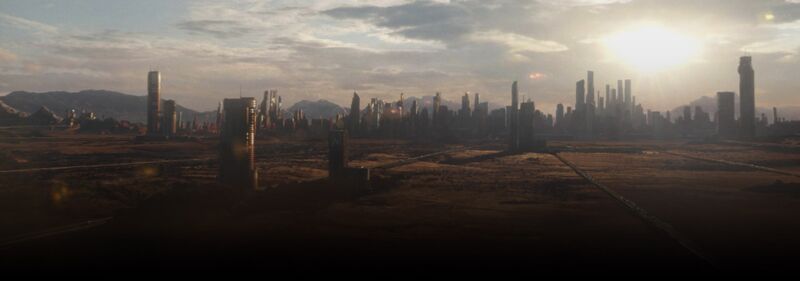
| « | New Phoenix was the fourth most populated city in the United Republic of North America after New York, Los Angeles, and Chicago. Its population was consumed by the Composer when the Didact attacked. —
|
» |
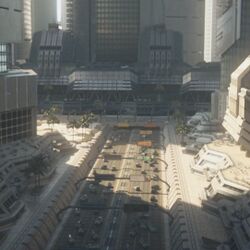
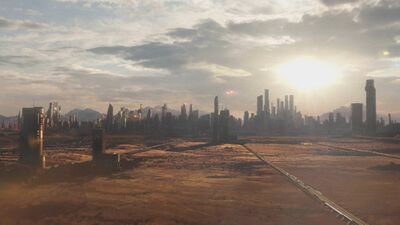
New Phoenix
Arizona, United Republic of North America, Earth
Government: United Earth Government
Population: Previously 6 Million
Performing Arts: New Phoenix Philharmonic
Summary
New Phoenix was originally two separate cities - Phoenix and Flagstaff - but as the cities continued to expand, they eventually merged into a single sprawling metroplex.
New Phoenix Incident
On July 25, 2557, the Didact arrived at Earth aboard his ship, the Mantle's Approach. In less than ninety seconds, over six-million people were consumed by the Didact’s Composer when the ancient machine extracted the human essences of the city’s population.
New Phoenix Rebirth Ceremony
Spartans Thorne and Grant attend reopening event for New Phoenix, inaugurated by UEG President Ruth Charet, on March 24, 2558.
Reach[modifier | modifier le wikicode]
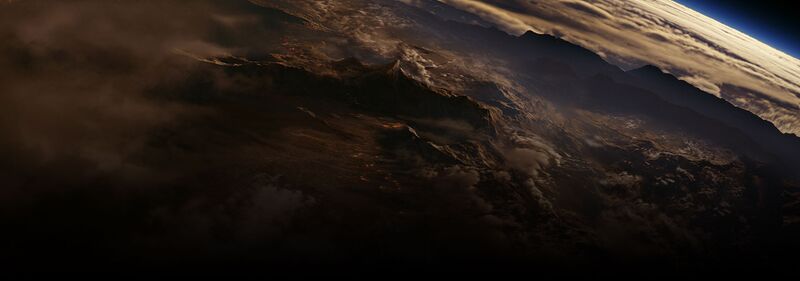
| « | Reach was humanity's greatest home and strongest military fortification before it fell to Covenant forces at the height of the Human-Covenant War. —
|
» |

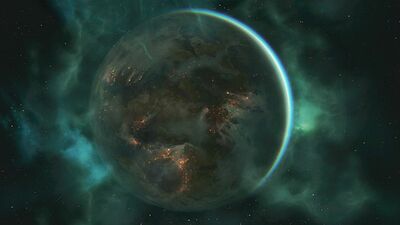
Reach
Epsilon Eridani II
Star System: Epsilon Eridani
Satellite(s): Csodaszarvas, Turul
Diameter: 9,490 miles (15,273 km)
Gravity: 1.08 G
Atmosphere: 1 (O2, N2)
Surface Temperature: -15°F to 108°F (-26°C to 42°C)
Day Length: 27 Hours
Year Length: 390 Days
Summary
The 4th largest planet in the Epsilon Eridani star system, Reach was the undeniable hub of humanity's military fortification—outside of Earth—possessing the UNSC's biggest and most prevalent shipyard. The planet was also home to the training facilities for the Orbital Drop Shock Troopers (ODST). Prior to the planet’s glassing by Covenant forces, the Epsilon Eridani fleet was a full strength Carrier Group headed by the supercarrier UNSC Trafalgar. The planet itself was armed with a semi-mobile array of 20 Orbital Defense Platforms, and defended by multiple wings of single ships and a vast array of tactical multi-role craft. However, the tragic events leading up to the planet's fall led to a fracture in the Covenant and eventually some measure of hope for the human species.
Requiem[modifier | modifier le wikicode]
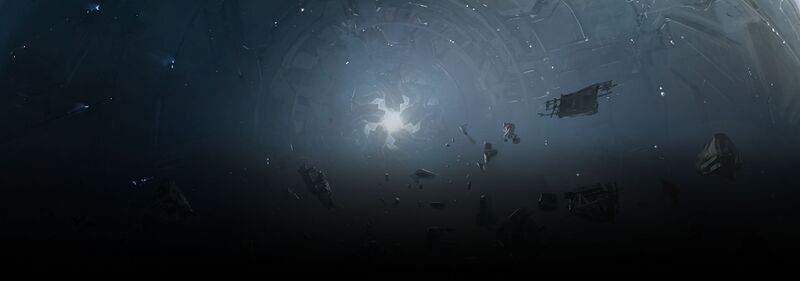
| « | Requiem was the first Forerunner shield world created as a fortress for the Didact, the Protector of Ecumene. —
|
» |

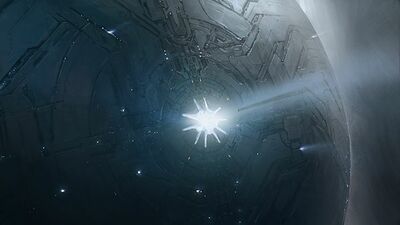
Requiem
Shield World 0001
Star System: Epoloch
Diameter: 6,703 Miles (10,787km)
Gravity: .987 G
Atmosphere: 1.2 (N2, O2, Ar)
Surface Temperature: -36°F to 159°F (-38°C to 71°C)
Summary
The shield world of Requiem is essentially an enormous series of concentric planetary shells enclosed within each other and hidden beneath a vast armored surface. This artificial planet was the Didact’s main refuge during his command of the Forerunner military. Requiem was placed in dormancy when the Didact’s wife, the Librarian, discovered his crimes against the humans and betrayed him, locking him away in a Cryptum. After his awakening, Requiem once again became a key strategic point for the Forerunner, and the UNSC would contend with this world, its extensive Promethean army, and its mysterious secrets for some time. Eventually, the artificial world was hurled into its system’s sun, Epoloch, and is presumed destroyed.
Key Sites
Apex - SITE REQ//3490-9299
The vast collection of islands just off the southwestern coast of Requiem’s smallest continent played host to a number of critical Spartan operations, forcing Infinity’s detachments to deal with both Covenant and Promethean elements throughout their protracted campaign on the shield world. Referred to as “Apex” by Spartan Command, this site appeared to have once been a translocation outlier, offering individuals and machines easy access across Requiem’s many environments through its incredibly large portal generator network. Scientists have since theorized that this site had other functions, as the data acquired from initial scans has offered deep insight into the Forerunners’ translocation technology.
Lockup - SITE REQ//0923-4303
The key site of a number of critical ground conflicts, the location deemed “Lockup” by Spartan Command was believed to have been an enormous staging ground for midsize Forerunner vessels. Prior to deployment into battle, Forerunner ships likely coalesced at this site and others similar to it, undergoing refits, repairs, and simply preparing for flight into deep space, with actuary drones taking estimates on numbers and firepower. Data acquisitions also hint that this site may have been relevant to the first deployment of Forerunner ships during their war against ancient humans, and specifically the Didact’s own ship, Mantle’s Approach.
The Cauldron - SITE REQ//8934-8829
Buried within a large volcanic mountain range, the site Infinity’s Spartans dubbed “The Cauldron” appeared to be a thermal processing system created by the Forerunners to power large-scale tension modifiers, which were used to stabilize atmosphere pockets deep within the planet. The Cauldron was the site of numerous conflicts, and eventually led to the discovery of a valuable artifact the Covenant desperately sought. This object and the secrets it held made the Cauldron one of the most significant battleground sites on Requiem, later leading the UNSC to the mysterious Janus Key.
The Refuge - SITE REQ//7848-2328
“The Refuge” was a site of great interest for the UNSC Infinity for the extent of its campaign. Although the site’s full purpose during the time of the Forerunners remains unknown, the Refuge’s near-inaccessibility deep within the vast northern jungle regions of the planet and its heavily fortified compartments hinted at it being a safe house of some sort. The discovery of a translocation conduit further validated this theory, in that Requiem’s occupants could activate a portal, safely delivering them to this site were the planet ever besieged by outside forces.
WARRENS - SITE REQ//3490-1189
During the Requiem campaign, Jul 'Mdama created a small outpost in a series of caves and underground Forerunner structures, strategically located near the Apex site. After recovering data from another Covenant outpost, Spartan Commander Sarah Palmer sent Fireteam Crimson to infiltrate the facility. Crimson cleared the area and hacked a local terminal, discovering the location of an important Covenant archaeological dig.
Later, Fireteam Lancer discovered that the Covenant had returned to the Warrens and created a new base. Lancer and Crimson joined forces in their assault on the facility. However, a shield wall with camouflaged power generators blocked the Spartan's access to the Warrens. After eliminating the Sangheili guards, the teams destroyed the exposed generators, bringing the shield wall down. The Spartans then detected a distress signal from deeper in the cave system. Inside a Forerunner structure hidden within the caves, Crimson came across Fireteam Switchback - who had gone missing while trying to disrupt a Covenant excavation - trapped behind another shield wall.
War Games
Complex - War Games Map_Set/: 615-3
UNSC Galileo Base, located on the northeastern coastline of Requiem’s largest continent, was a critical site during Infinity’s protracted ground campaign in the months following the reemergence of the Covenant. Although this location was intended to be a science facility, ONI enforced what they referred to as “Persistent Field Resilience,” a mandate that required combat readiness regardless of perceived environmental safety. This precaution proven well-founded, as the Covenant laid siege to Galileo numerous times, spurring multiple Spartan fireteams into action.
Forge Island - War Games Map_Set/: 230-1
Referred to as the ‘Great Anvils’ by UNSC personnel deployed to the southwestern peninsula of Requiem’s smallest continent, these massive sentinels towered high above the shield world’s warm tropical ocean. The geologic data acquired from these islands has offered incredible fodder for Infinity Science’s Forge group, providing diverse and modifiable terrain for the War Games combat simulations.
Haven - War Games Map_Set/: 389-4
Many worlds created by the Forerunners play host to vast ecosystems that are ultimately fed by an artificial sun. On Requiem, such suns were formed and maintained by a massive grid of harmonic resonance platforms—intricate and powerful structures hidden high above the surface of the world that operate in perpetuity to ensure its safety. During UNSC Infinity’s initial scans of Requiem, the technicians captured extremely detailed scans of a number of these structures and, believing they might be useful during combat simulations, sent them to the War Games AI for review and possible integration.
Ragnarok - War Games Map_Set/: 733-4
Enigmatic and multi-purposed, spire beacons similar to these apparently frequent a number of Forerunner sites, including Halo and Shield installations, as well as the Ark megastructure. Buried within deep canyons, these towers are not only sheltered from off-world debris, but their positions allowed them to leverage the steep environment’s natural harmonics to amplify their signals when firing deep into space. Most scientists believe the spires - at their base function - act as communication channels, sending specific commands to other remote locations. The full operation and over-arching purpose of these mysterious objects, however, remains a source of speculation.
Ravine - War Games Map_Set/: 982-3
During a number of classified planetside expeditions conducted in this part of Requiem, specific teams were dispatched to ascertain the purpose and function of the many citadels towering over this tropical sea. To their surprise, a series of deep-sensor seismic scans revealed the structures were actually part of a far larger construct hidden below the sea. Assumptions among analysts vary, but the most widely accepted theory is that the citadels are rampart-like towers rising above the apex of the hidden Forerunner creation, somehow acting like automated battlements of an impossibly large castle.
Vortex - War Games Map_Set/: 259-3
Perhaps the most intriguing collection of structures on Requiem, this shield world’s equator played host to a number of large-scale pressure harvesters—massive complexes that attempted to harness the planet’s violent squalls for energy. The precise function of these machines remains a mystery, but some science personnel attached to pioneer recon groups believe that a proper understanding of their inner workings could yield an unprecedented amount of affordable, clean energy for the Unified Earth Government. Due to unexpected hostilities, the science teams dispatched to this site were quickly recalled after acquiring a number of detailed environmental scans for further analysis.
Sedra[modifier | modifier le wikicode]
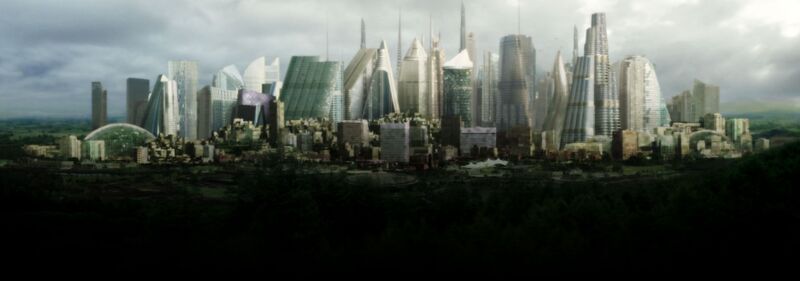
| « | Sedra is an outer colony world with lingering distrust of the UEG. It was left largely unaffected by the Human-Covenant War. —
|
» |
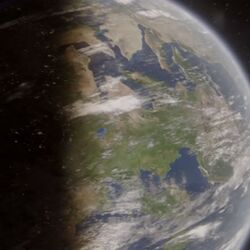
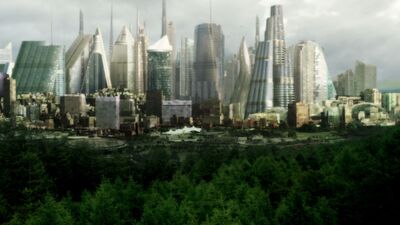
Sedra
Orrichon-III
Star System: Orrichon System
Gravity: 1.01G
Atmosphere: 1 (O2, N2)
Surface Temperature: -19°F to 111°F (-28°C to 44°C)
Summary
Sedra is an outer colony world in the Orrichon star system. Despite the heavy toll taken on human colonies as a whole throughout the Human-Covenant War, Sedra was among the colonies that were lucky enough to have escaped the conflict virtually unscathed. This has allowed Sedra to remain largely autonomous from the UNSC, though the colonial government has maintained relatively close ties in regards to military hardware acquisition. As a result, the Sedran Colonial Guard has been able to remain relatively well-equipped in efforts to safeguard their colonists.
Sanghelios[modifier | modifier le wikicode]
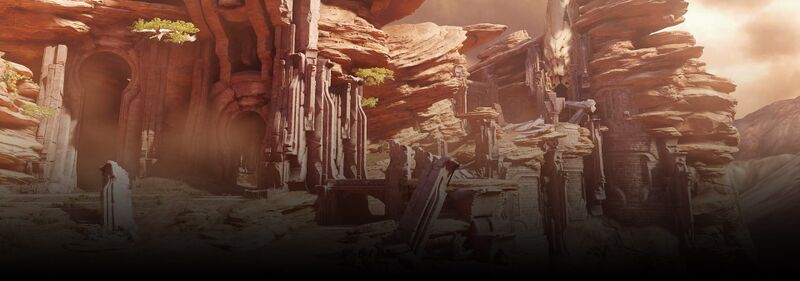
| « | Sanghelios is the cradle world of the Sangheili species, known to humans as ‘Elites,’ and currently the site of their largest population and governing control. —
|
» |
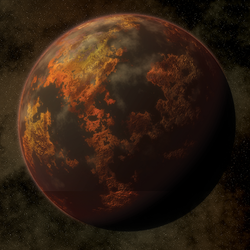
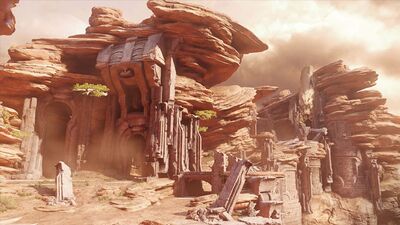
Sanghelios
Urs IV
Star System: Urs-Fied-Joori
Satellite(s): Qikost, Suban
Diameter: 9,344 miles (15,038km)
Gravity: 1.375 G
Atmosphere: .9 atm [N2, O2, Ar]
Surface Temperature: 23°F to 204.8°F (-5°C to 96°C )
Day Length: 29.5 hours
Year Length: 583.3 days
Summary
The planet of Sanghelios is the primary home for the Sangheili species, and was once host to a population of over eight billion. In the aftermath of the civil war however, the planet’s population has dwindled to less than four billion in total. Many victims fled to Qikost and Suban, Sanghelios’ pair of moons, which now host large population centers, major industrial sites, and a number of significant armories. This sudden shift in population density and the territorial vacuum created in its wake has placed the planet’s remaining citizens in a chaotic state of political unrest, with keeps clashing against keeps for territory and governance.
History
Sanghelios, as the cradle world and center of government for the Sangheili people, was a pivotal site during the War of Beginnings (938-852 BCE), which would eventually result in the Writ of Union and the founding of the Covenant. The Covenant used this world as its primary outpost until the completion of High Charity in 648 BCE, after which it returned to Sangheili exclusivity, fostering soldiers for the Covenant military over the centuries which followed.
After the decades-long war with the humans ended in 2552 CE, the Sangheili soldiers returned to their homeworld only to discover that the dismantling of the religious and political moorings of the Covenant had resulted in feuding and civil unrest. The Arbiter Thel ‘Vadam, though reluctant, was considered by most to be the Sangheili’s ad hoc leader during this time, but his relationship with humanity was highly disputed, leading to further conflict.
Since this time, Sanghelios has remained in a constant state of civil war in what would later be called the Blooding Years, even after the reemergence of the Covenant under the leadership of Jul ‘Mdama. Currently, Sanghelios remains in a tense state, as do many Sangheili colonies. With the Arbiter’s efforts toward unity for his people and peace with the humans threatened by both secular and religious parties.
Geography
Sanghelios is largely composed of water, though it has five individual continents: Yermo, Tolvuus, Kaepra, Qivro, and Vaardma. Large desert regions stretch across the interior portions of the continents, forcing the vast majority of Sanghelios’ populations to live on the coasts and islands, locations which are usually girded by steep mountain ranges or rocky tombolo drifts and provide protection during the planet’s harrowing rain season.
Sunaion[modifier | modifier le wikicode]
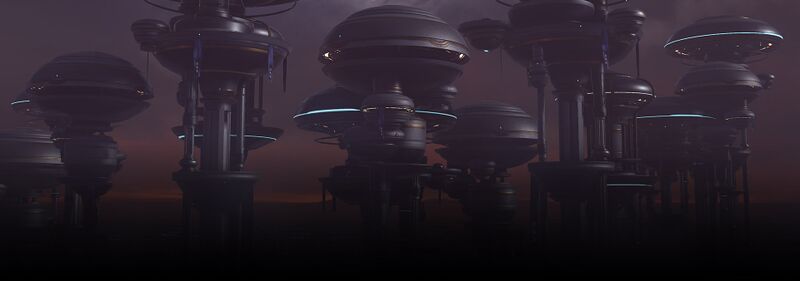
| « | Resting high above the Csurdon Sea, the city of Sunaion was constructed to pay homage to the Guardian concealed in the deep below. —
|
» |
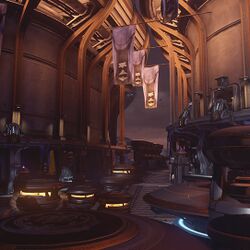
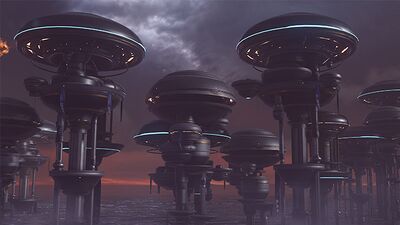
Sunaion
Westward Temple of the Sea
Planet: Sanghelios
Continent: Qivro
Function: Site for worship and contemplation
Summary
Along the coastlands of Nuusra, ancient Sangheili elders had once erected stone fortresses to observe and protect a site they deemed sacred -- a mysterious and immense machine that had first been discovered by dive-hunters and fishing skiffs. Centuries later, the Sangheili built a temple city on pylons even closer to the submerged relic, now recognizing it belonged to their gods, the Forerunners. This city was called Sunaion.
For many years, the Covenant leveraged Sunaion to explore and worship the artifact they came to know as a Guardian, but little could be done to explore the secrets of the great machine or determine its true purpose. Except for a number of anchorites, the city remained mostly empty during the Covenant’s reign and their war with humanity, though prophecies of the Guardian one day rises began to be inscribed.
Staging Site
After the war, Sunaion initially remained neutral amid a flurry of civil skirmishes among kaidons. When the Arbiter’s own territory became a target of would-be revolutionaries, however, this all changed. Sunaion was now viewed as an optimal staging site, giving one quick access to the coasts of Yermo, including Vadam Harbor and the heavily fortified Kolaar Mountains.
Jul ‘Mdama’s Covenant eventually gained control of the temple site, and began formulating plans to strike at the Arbiter while he defended the inland portions of Vadam. The Arbiter got wind of this activity and quickly established a forward operating site among the ruins of Nuusra, where the Arbiter’s Swords of Sanghelios planned to strike at the Covenant forces. When ‘Mdama was suddenly assassinated by humans, the Arbiter had been afforded an opportunity to execute one final crushing blow to the Covenant’s last bastion. During the assault, however, the Guardian suddenly awakened, violently ripping Sunaion apart in its wake.
Threshold Gas Mine[modifier | modifier le wikicode]

| « | This gas mine is a Forerunner mining facility suspended above the gas giant, Threshold, and tethered to a larger orbital installation. —
|
» |
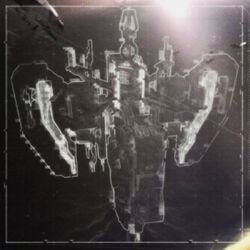
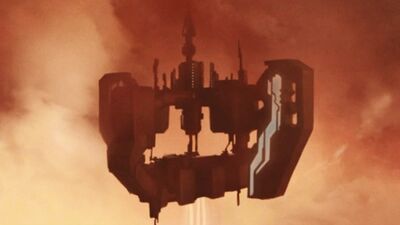
Threshold Gas Mine
Forerunner Mining Facility
Gravity Anchor: Threshold
Origin: Forerunner
Usage: Hydrogen, helium, and methane collection and refinement
Product: Hydrogen, helium, and methane collection and refinement
Summary
This gas mine is a Forerunner mining facility orbiting the gas giant, Threshold. Its construction actually predates Installation 04 by several hundred years, but was retrofitted to research possible offensive and defensive measures against the Flood. Monitor 343 Guilty Spark oversaw the design and construction of the facility's various outbreak management systems.
Upon discovery of the nearby Halo ring in 2552, a Covenant minor prophet known as the Prophet of Stewardship ordered expeditionary forces sent to outlying facility, the detachment led by Sesa ‘Refumee and Loka ‘Bandolee. This order angered then-Fleet Master Thel ‘Vadamee, who felt all local forces should be concentrating on combating the human presence and protecting Halo. Thel issued a close-band transmission demanding all military forces concentrated on the human threat posed to the Holy Ring. This order was ignored, and the Ring eventually destroyed by the Master Chief.
The blame for Installation 04’s destruction was placed on Thel ‘Vadamee, who was then stripped of his military power but repurposed as the newest Arbiter. His first mission was to travel to the Threshold Gas Mine to silence the contingent led by his once-ally Sesa ‘Refumee. These Covenant soldiers turned “heretics” after discovering that the Prophets had been lying about the nature of Halo. Although the Arbiter killed ‘Refumee, it is revealed ‘Refumee had possession of an Oracle, the monitor of Alpha Halo, 343 Guilty Spark.
Threshold[modifier | modifier le wikicode]
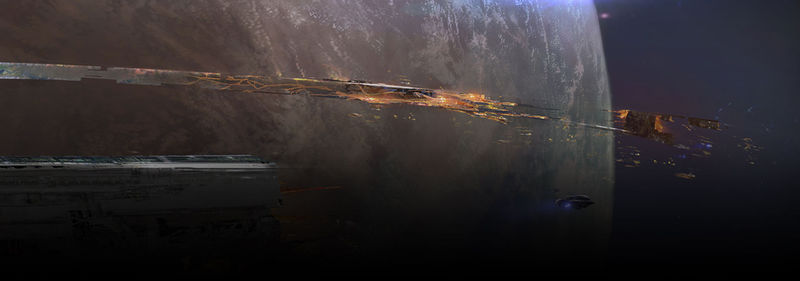
| « | Threshold is an enormous gas giant in the Soell system. It has an extensive network of Forerunner gas mining and refinery stations and was once orbited by Alpha Halo. —
|
» |
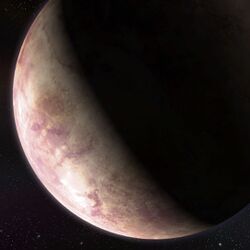

Threshold
Soell-VII
Star System: Soell
Satellite(s): 12
Diameter: 133,348 mi (214,604 km)
Atmosphere: H2, He, CH4
Relevance: Gravity anchor for Installation 04
Summary
Before its destruction, Alpha Halo orbited a large gas giant known as Threshold (Earth Survey Catalogue Number B1008-AG), anchored at the L1 Lagrange point between the planet and its largest moon, Basis. An extensive network of Forerunner gas mining and refinery stations was suspended in the atmosphere through a number of band orbitals, though only a handful remained active into the modern era.
While Basis is by far its largest moon, eleven other satellites orbit Threshold. These satellites have not been extensively surveyed, though all but two appear to either house some sort of Forerunner installation or are entirely artificial. The function that these outposts served remains unknown, but most evidence indicates they provided maintenance for Alpha Halo.
Current Status
A 500 light-second exclusion zone is currently maintained around Threshold, with both Sangheili and human warships patrolling the region as part of the post-war treaty between those species. Uncontrolled Sentinels, volatile Halo fragments, micro-debris, malfunctioning Forerunner artifacts, and the ever-present danger of the Flood make even surreptitious exploration and scavenging too dangerous for most.
Locations
Colossus - War Games Map_Set/: 201-7
Similar to the mining facility which the once-heretic leader and now-deceased Sesa ‘Refumee took occupation of, the War Games map called ‘Colossus’ is a separate and distinct Thresholdian satellite. Acquired by scans conducted by the UNSC Red Horse in its survey of the area, and also later corroborated by human-Sangheili dialogues, this structure mined gas from the high above Threshold’s roiling ‘surface.’ The environments symmetry, scalability, and obstacles presented unique challenges to Spartans training in the War Games, and thereby became a favorite of fireteam leaders, particularly for objective-based combat simulations.
Talitsa[modifier | modifier le wikicode]
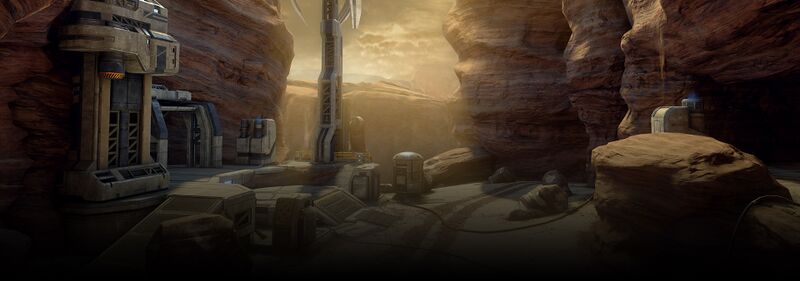
| « | The outer colony of Talitsa is one of twenty-seven natural satellites of a gas giant in the Sverdlovsk System. —
|
» |
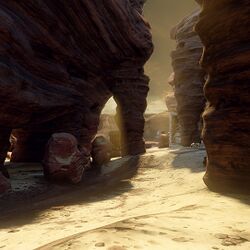
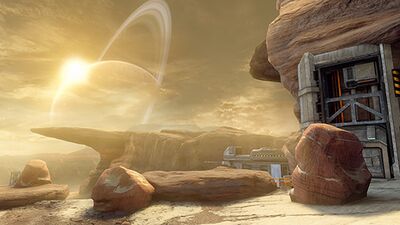
Talitsa
Vitalyevna III
Star System: Sverdlovsk
Gravity: .90 G
Atmosphere: .95 (O2, N2)
Government: Talitsa Corporate Council
Major Cities: Bedinka, Irbit, Khutors, Yushala
Summary
The colony of Talitsa has always had a strong anti-centralization and pro-colonial autonomy sentiment, forcing UNSC intervention after a series of uprisings in the planet’s major population centers in 2493, 2516, and 2520. The results of these military actions were less than ideal, with many outlying rebel sects coalescing into larger and stronger groups that ultimately made the planet ungovernable outside of the heavily fortified capital. Though these groups officially disbanded in 2528, separatist sentiments remain high.
Outland Bases
Outcast - War Games Map_Set/:822-2
Some of the Talitsa rebels’ outland redoubts sites have been discovered by the UNSC following the Covenant War, but many others remain well-hidden, sparking concern within the upper echelons of the Unified Earth Government (UEG) that the planet’s population will once again erupt in armed confrontation. The UNSC acquired scans of a known rebel base in the distant outlands of Talitsa for use in the War Games simulations.
Tribute[modifier | modifier le wikicode]
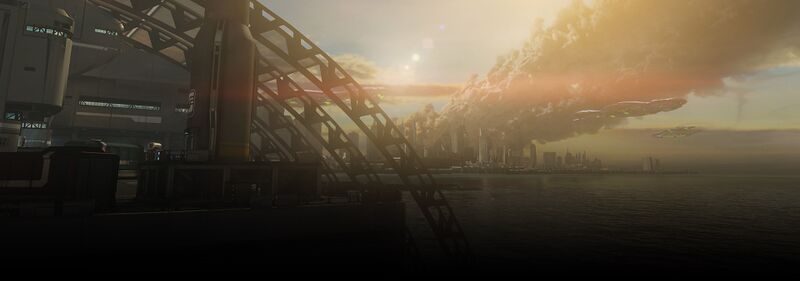
| « | The youngest of Epsilon Eridani’s colonies, Tribute was known for its thriving industry until it was partially glassed by Covenant forces in 2552. —
|
» |
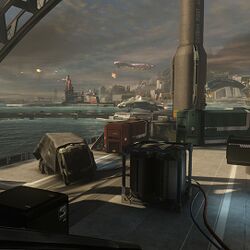
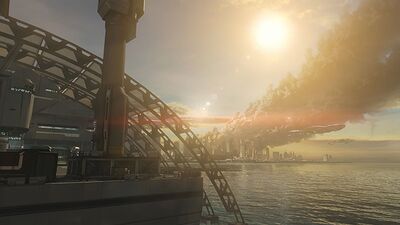
Tribute
Epsilon Eridani III
Star System: Epsilon Eridani
Satellite(s): Epsilon Eridani
Diameter: 8,700 Miles (14,000 KM)
Gravity: 1.08 G
Summary
In close proximity to the military complexes and industrial might of Reach, Tribute was one of the most prominent commercial colonies in all human-occupied space. Its fall in 2552 marked not only one of the defining tragedies of the Covenant War, but also had huge economic ramifications on Earth and the surviving colonies in the post-War period.
Colonization
The Epsilon Eridani system contains an improbably high number of habitable planets, a fact that was seen as serendipitous to the early colonization efforts, which (at the time) faced significant challenges in marshalling political and economic support. Interest in the system’s colonization potential initially focused on Tribute and Circumstance, though it was Reach that would soon capture the attention of UEG planners.
Tribute was the second planet to be colonized in the Epsilon Eridani system, though date of establishment is contested. The UEG officially records colonization as beginning on August 8, 2364 with the establishment of the initial navigation and communication satellite constellation and landing of CAA Casbah, though personnel attached to the CAA Irbid claim they landed earlier, on July 24th.
Operation: TREBUCHET
In 2524, Tribute became a focus of the long-running counterinsurgency program Operation: TREBUCHET when the UNSC learned several major Insurrection cells were hiding on the planet. Initial efforts to root out the rebels failed spectacularly, triggering a wave of bombings, assassinations, and UNSC raids in urban areas that led to massive numbers of civilian casualties. Insurrection fighters initially enjoyed tacit support from the population, though as violence escalated it quickly became clear the rebels were not the romantic freedom fighters imagined by many and their popular support waned.
Periodic outbreaks of Insurrection violence continued for over a decade, though the destruction of the Outer Colonies and draconian restrictions on inter-system transport effectively cut off the Tribute rebels from any outside support. A handful of rebels remained active even to the eve of the Covenant assault on the planet, perhaps convinced that the war aganst the alien alliance was simply a plot by the UEG to shore up support in the colonies.
Covenant War
When the Covenant launched their invasion of Reach in 2552, they simultaneously attacked all other human colonies in the Epsilon Eridani system. Despite the brave efforts of UNSC forces, the Covenant soon gained the upper hand in the fight for Tribute and began targeting population and industrial centers for plasma bombardment. Brute forces also began to land in force, though stiff UNSC and civilian resistance left the packs bloodier than their chieftains had anticipated. However, with the Covenant in uncontested control of the skies there was little could be done to save the colony.
Salvation came – ironically – from the Covenant’s High Prophets of Truth and Regret, who both began to consolidate their loyal forces once the first holy ring – Alpha Halo – was discovered. The few remaining ships at Tribute listlessly targeted human forces when able, but otherwise simply waited for new orders and began moving orbital wreckage in preparation for a renewed campaign of planetary cleansing. The Jiralhanae and Sangheili vessels then fought each other during the Great Schism, tearing each other from skies while the human survivors could only look on in confusion.
Post War
Tribute was not razed or completely glassed during the Covenant siege, but all of its major cities were levelled and few industrial sites survived unscathed. Over half of the population was dead, and Earth could scarcely afford to spare any immediate assistance with Sol’s colonies in ruins. Nevertheless, the colony survived, and enough infrastructure remained intact that survivors began rebuilding the ecology and economy.
Notable Environments
Landfall - War Games Map_Set/: 891-3
During one of the last battles in the capital city of Casbah, a single Spartan fireteam held off a brutal Covenant assault to provide cover for escaping civilian transports. The evacuation site has since been immortalized as a War Games simulation used for training a new generation of Spartan warriors.